Ultra-Intense, High Spatio-Temporal Quality Petawatt-Class Laser System and Applications
Abstract
:1. Introduction
2. Design and Performance of Ultra-Intense “J-KAREN” Laser System

2.1. Front-End System
2.2. OPCPA Preamplifier
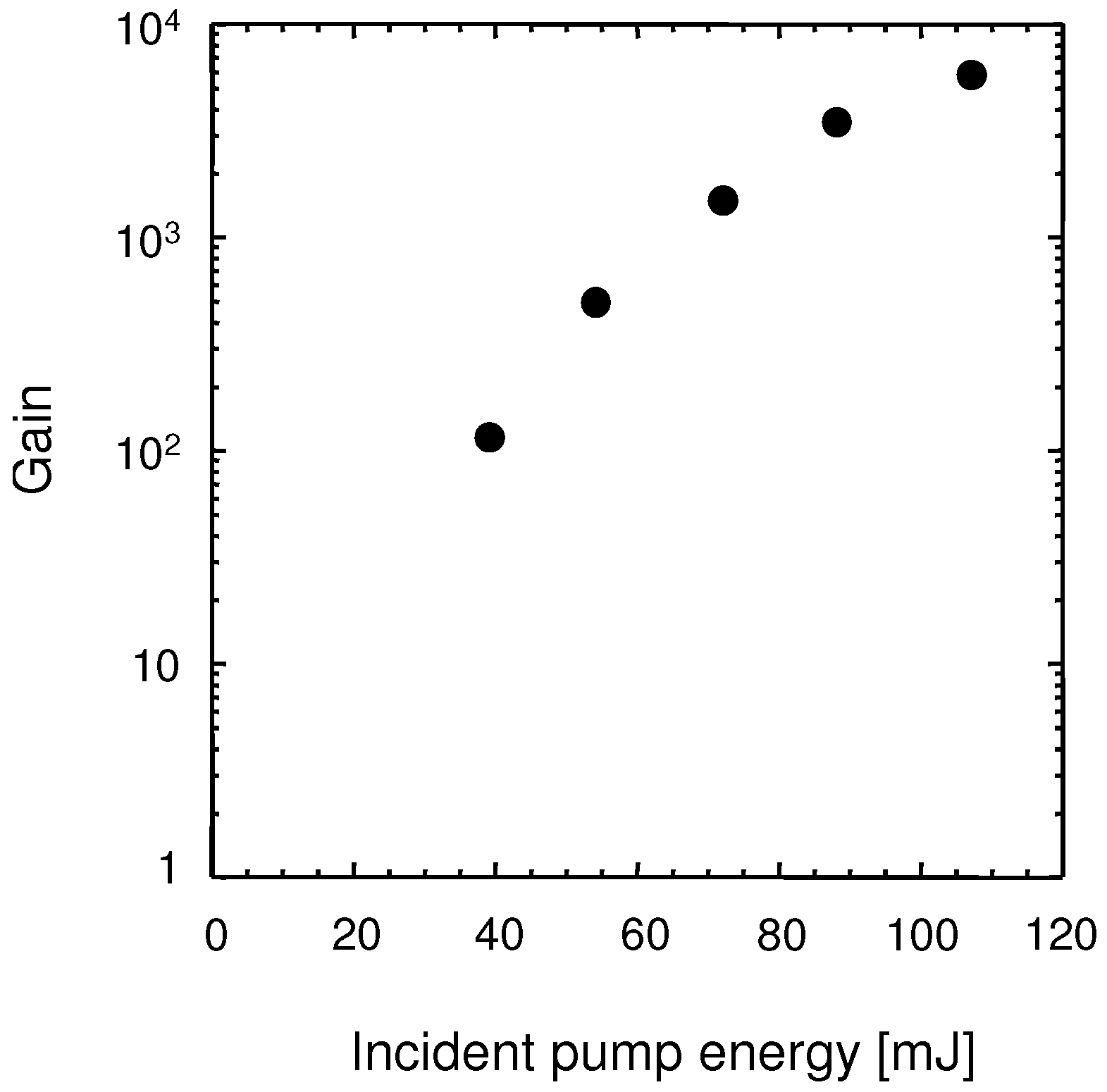
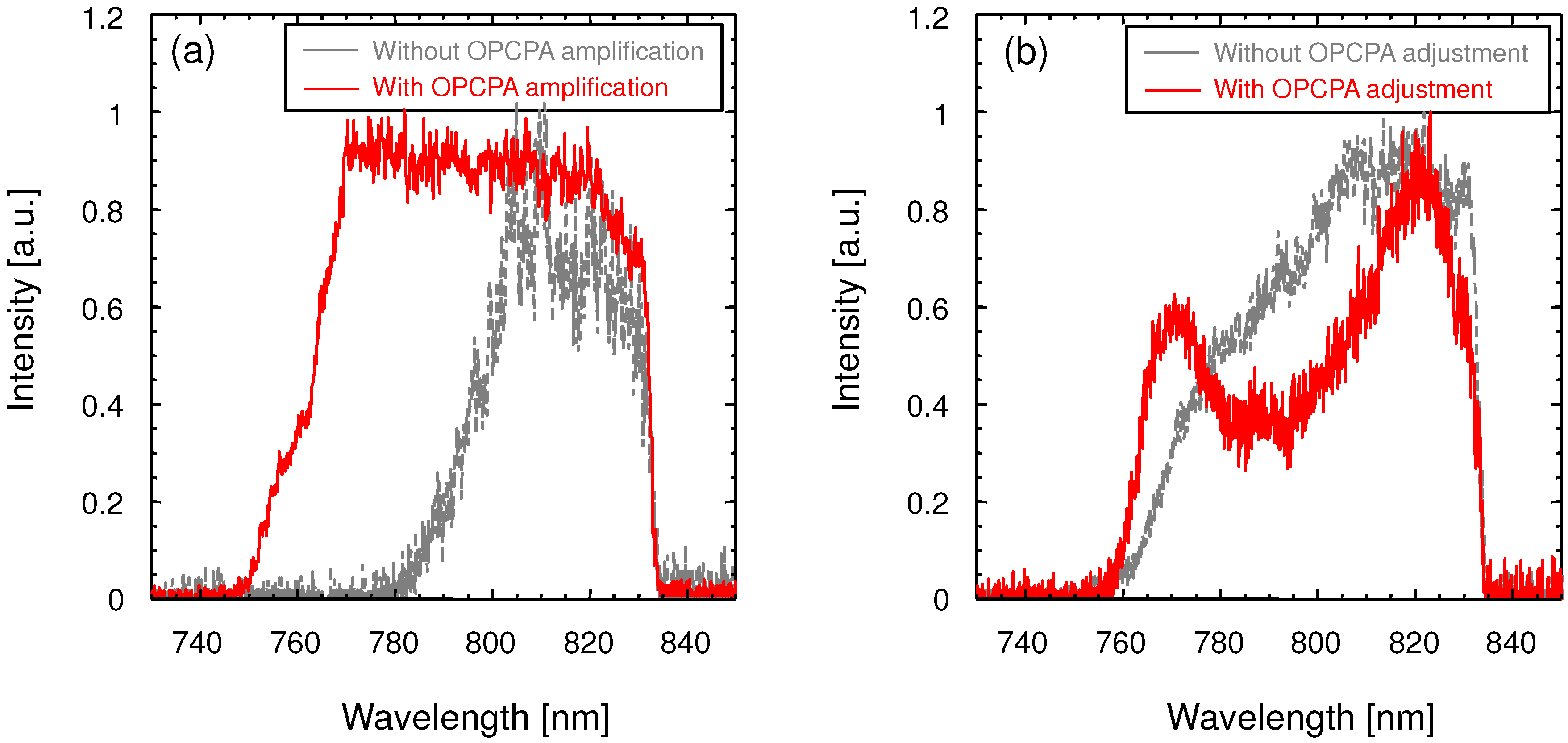
2.3. Cryogenic-Cooled Ti:sapphire Power Amplifier
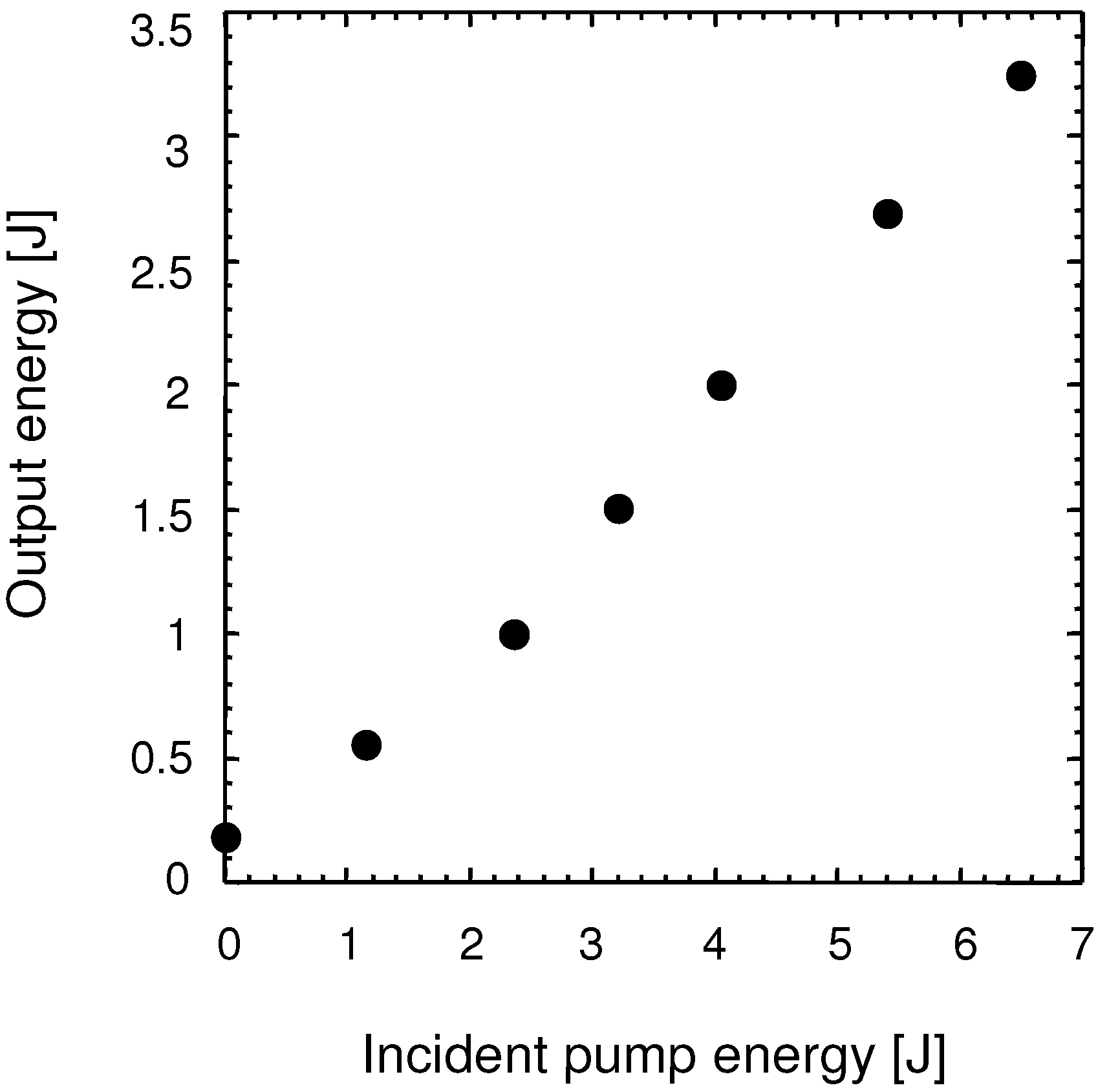
2.4. Large-Aperture Ti:sapphire Final Amplifier
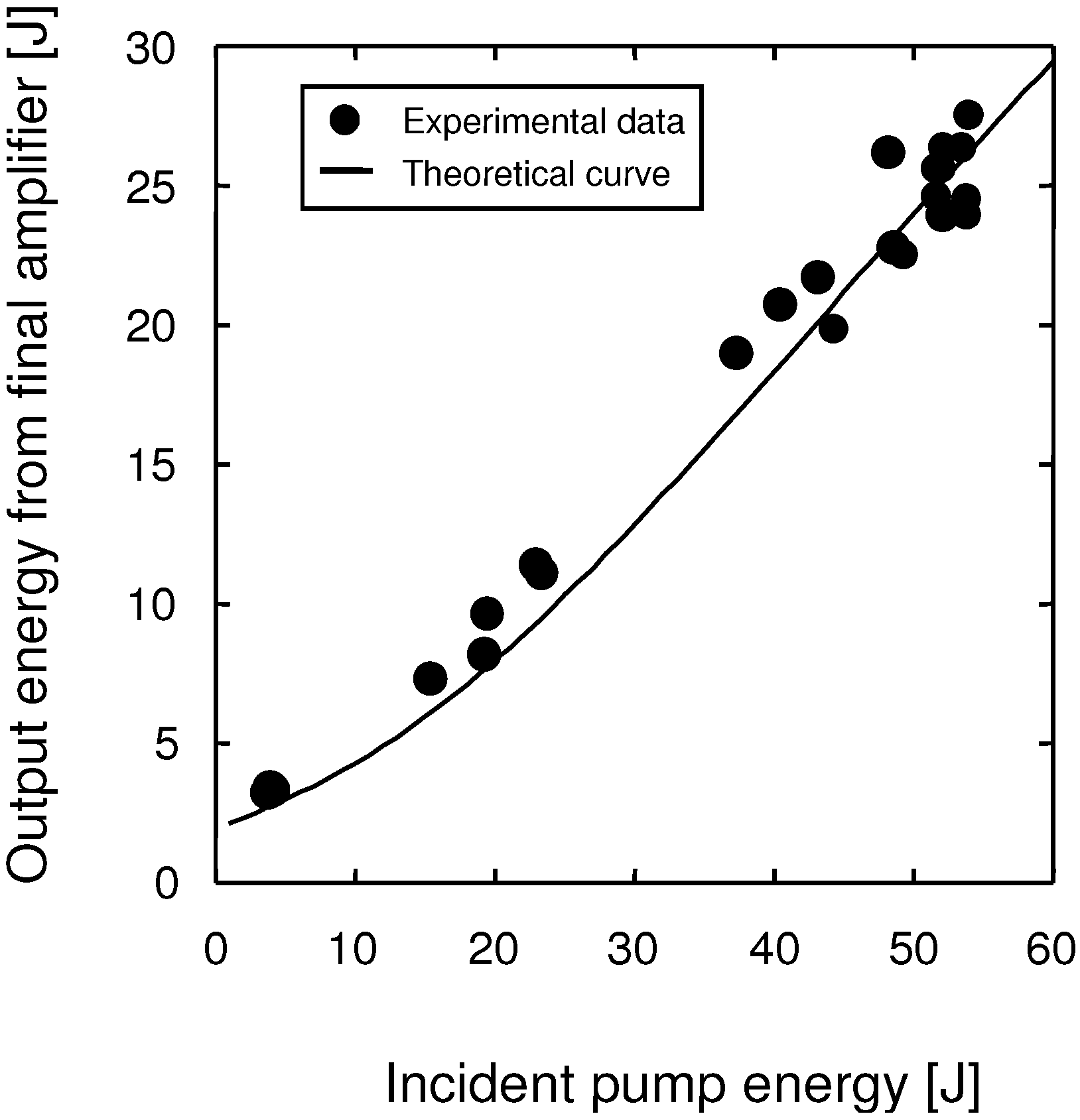
2.5. Spatiotemporal Quality
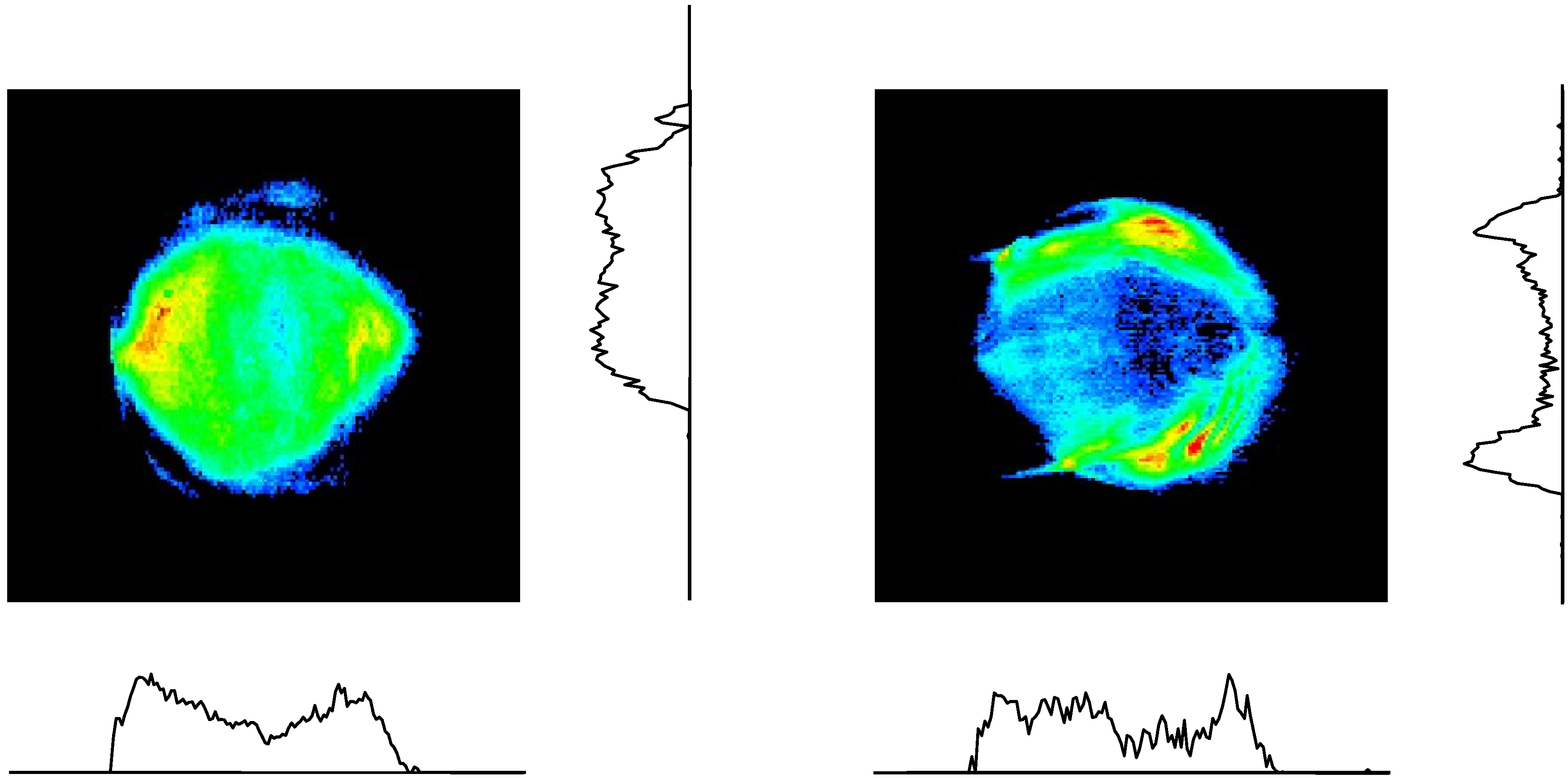
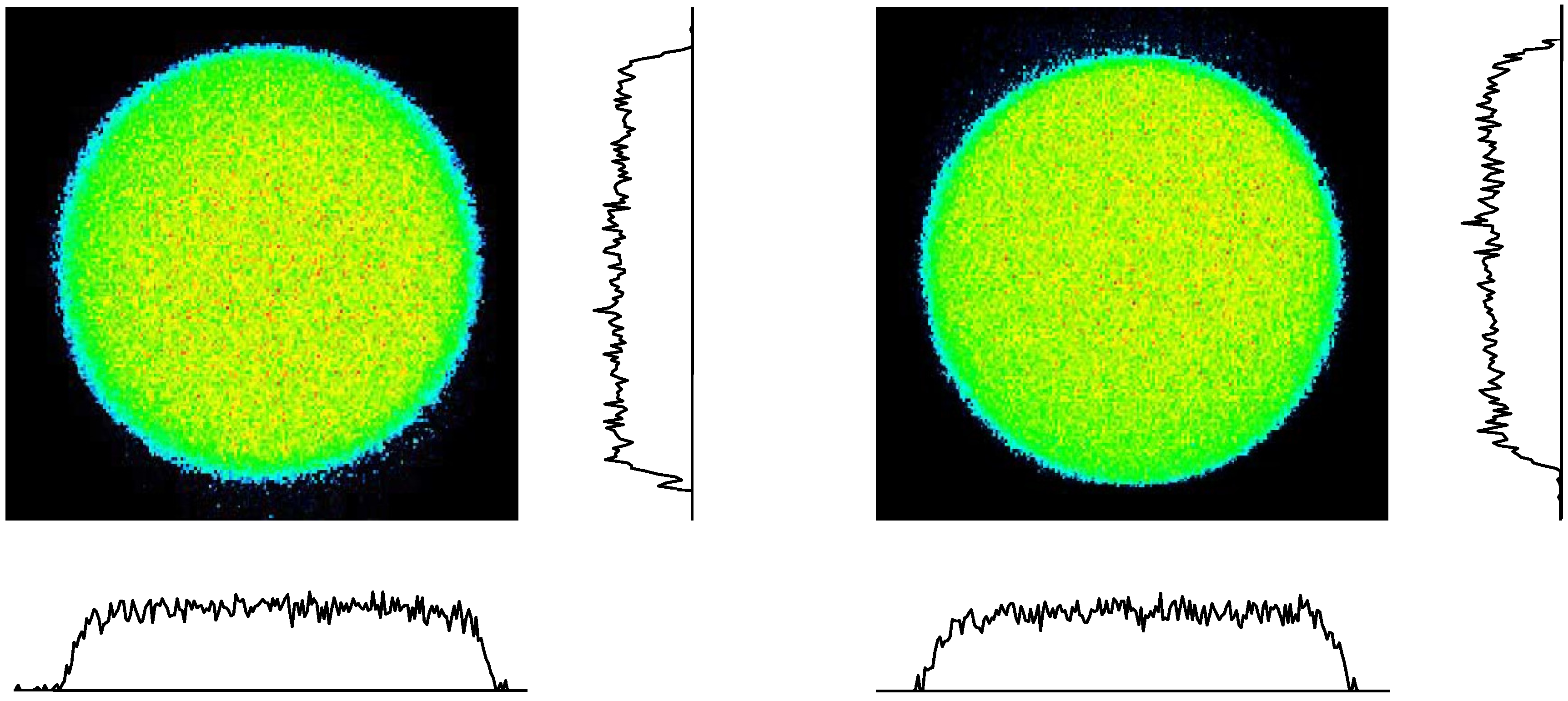


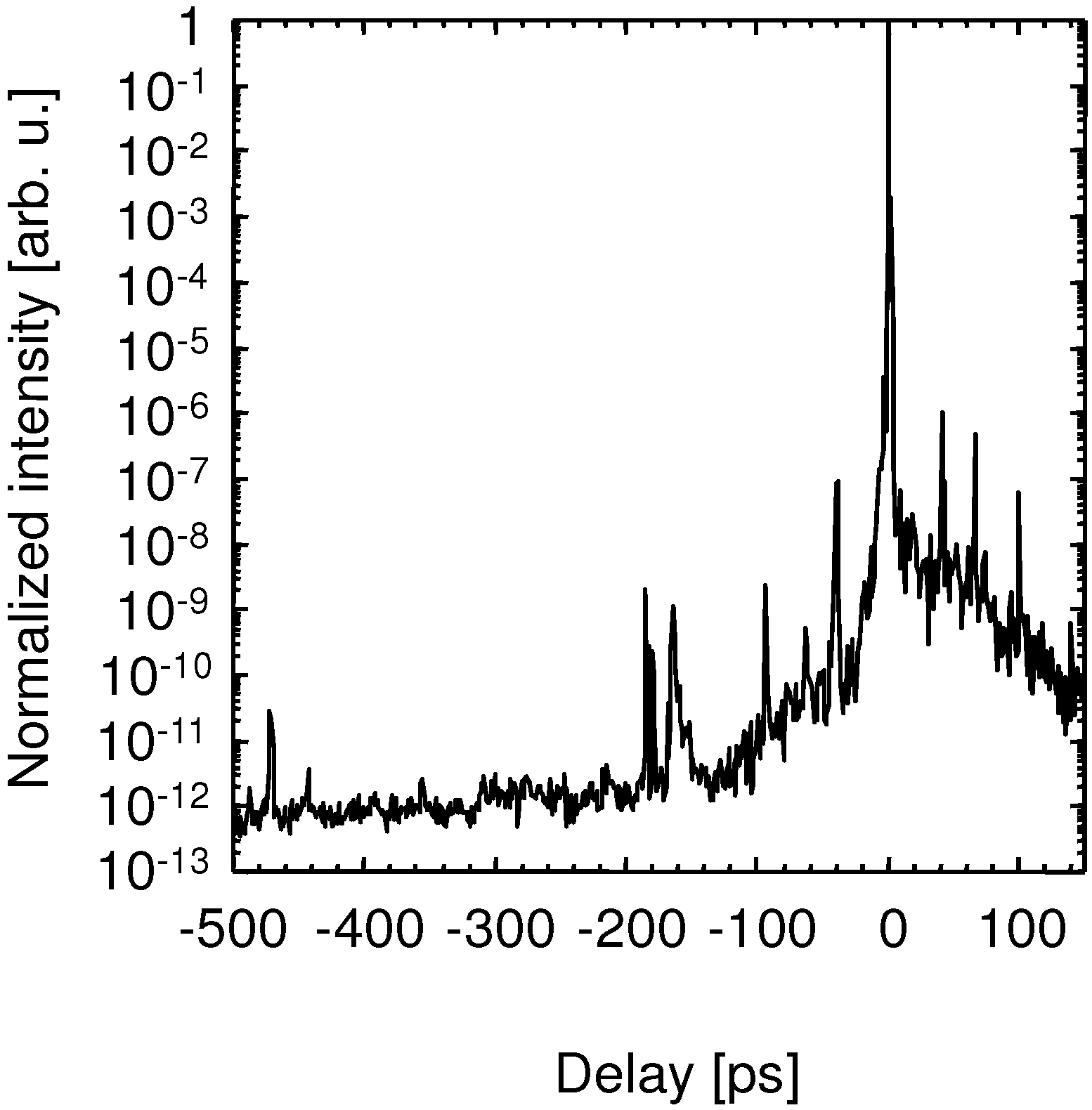
2.6. Improvements of Pointing Stability
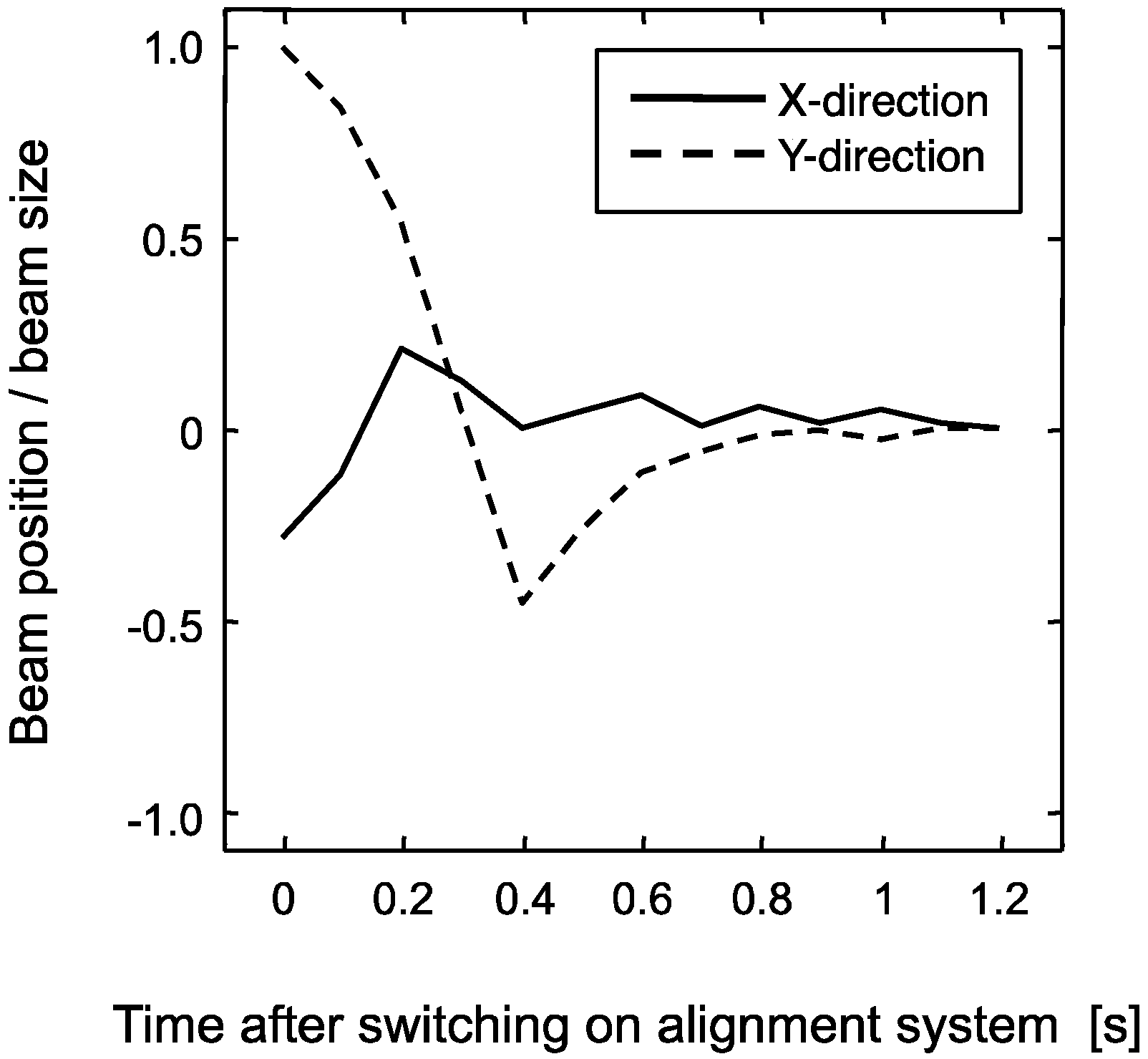
3. Applications with J-KAREN Laser System
3.1. Laser-Accelerated Protons from Thin Foils

3.2. Laser-Accelerated Ions from Cluster-Gas Targets

3.3. Laser-Accelerated Electrons from Gas Targets
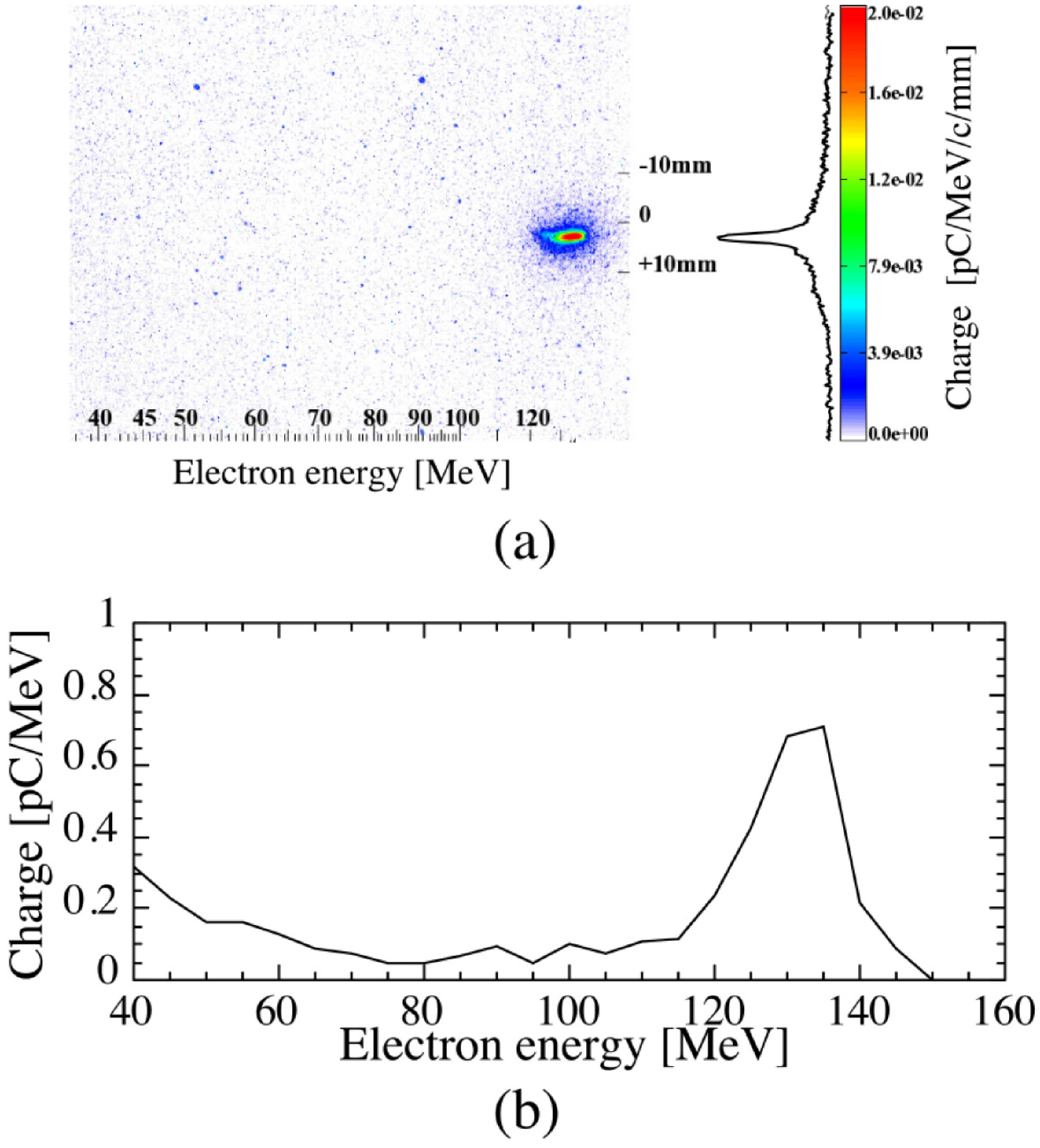
3.4. Xuv Electromagnetic Wave Generation via Flying Mirror
 and the pulse duration is compressed down to
and the pulse duration is compressed down to  due to the double Doppler effect, where γph = {1 − (vph/c)2}−1/2 is the Lorentz factor associated with the RFM, ωs and τs are the frequency and the pulse duration of the source pulse, respectively. After the proof-of-principle experiment [86], we conducted an improved experiment with head-on configuration using the J-KAREN laser system [87]. Here we describe the summary of the experiment.
due to the double Doppler effect, where γph = {1 − (vph/c)2}−1/2 is the Lorentz factor associated with the RFM, ωs and τs are the frequency and the pulse duration of the source pulse, respectively. After the proof-of-principle experiment [86], we conducted an improved experiment with head-on configuration using the J-KAREN laser system [87]. Here we describe the summary of the experiment.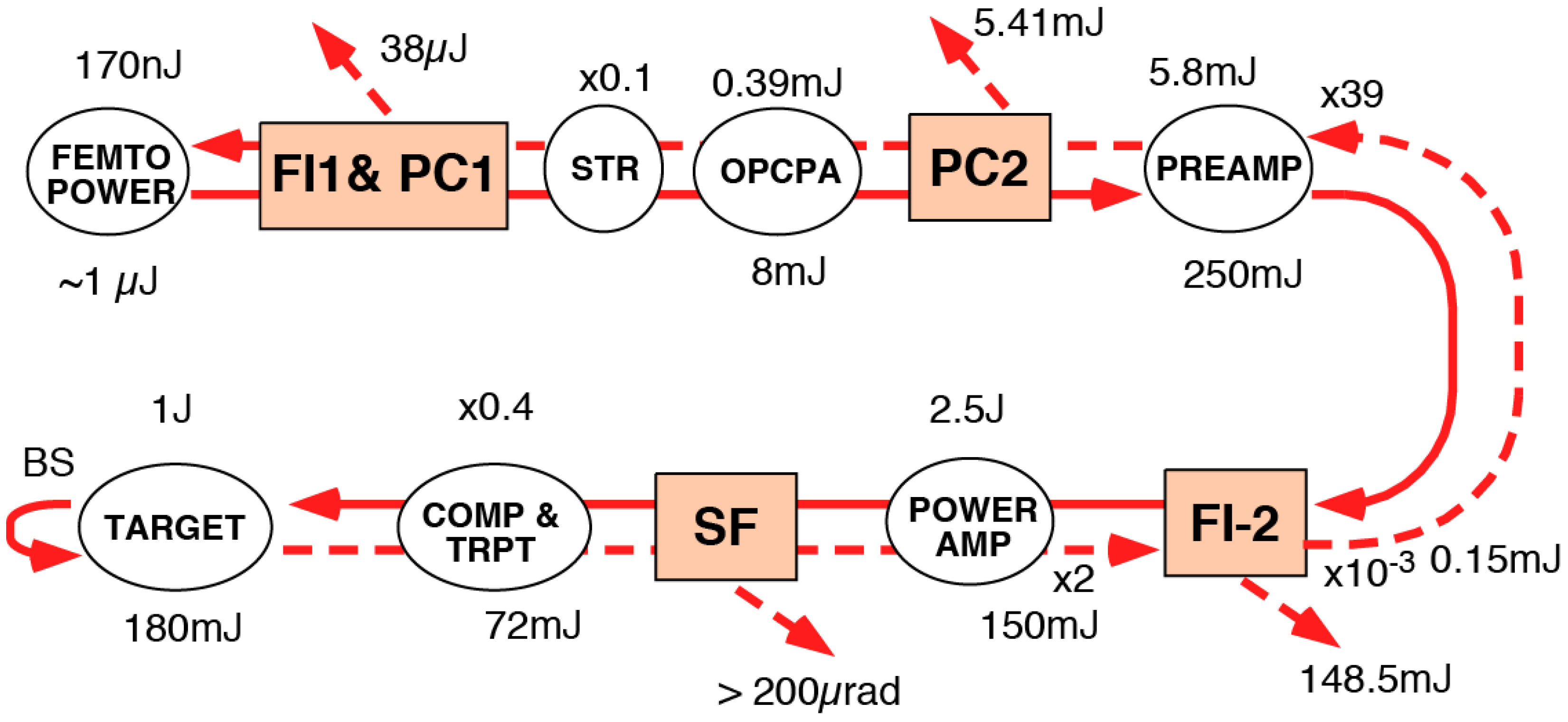
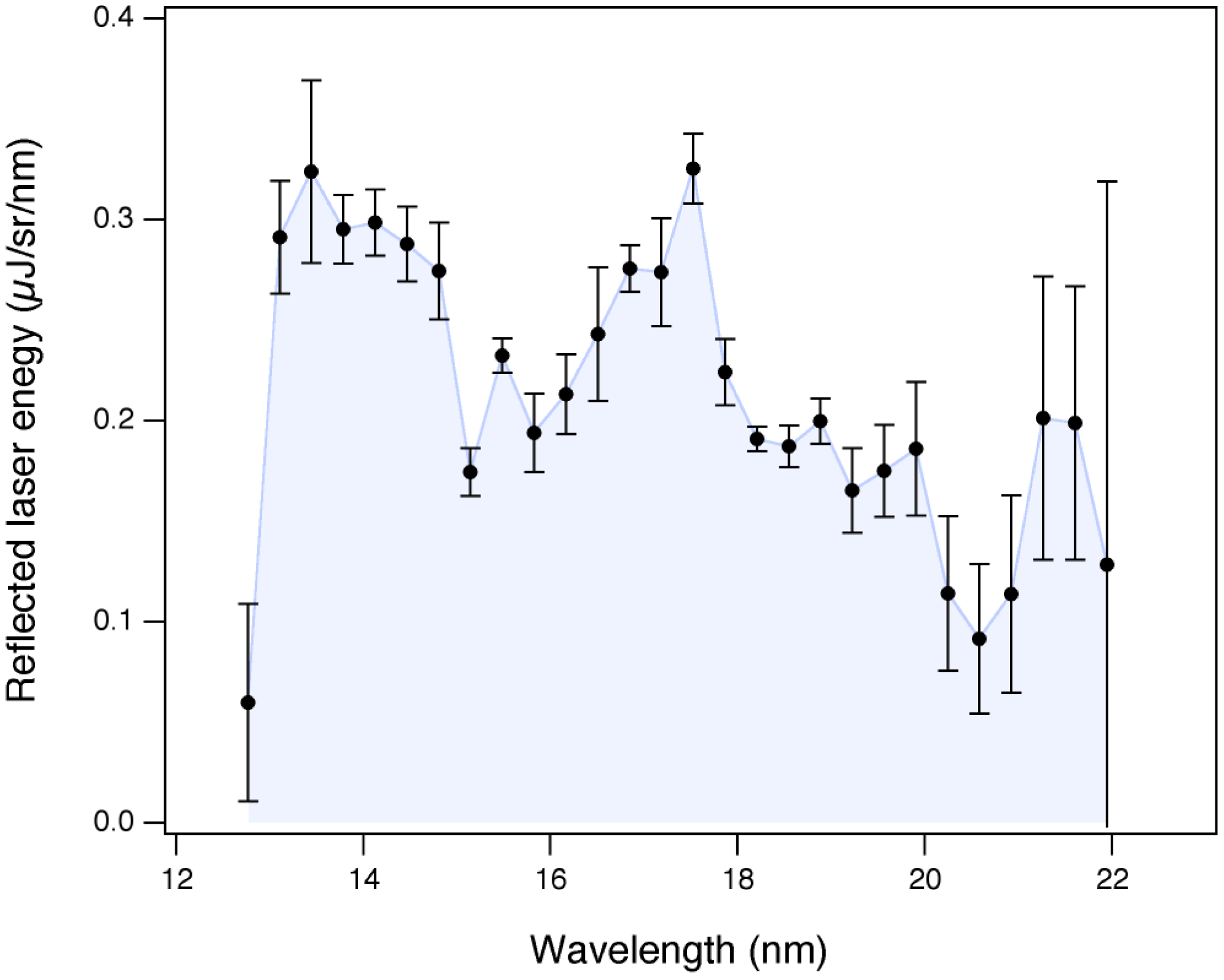
3.5. Hard X-ray Generation with Laser-Cluster Interaction

3.6. Soft X-ray Harmonic Comb Generation

3.7. Radiation Biology with Laser-Accelerated Proton Beams
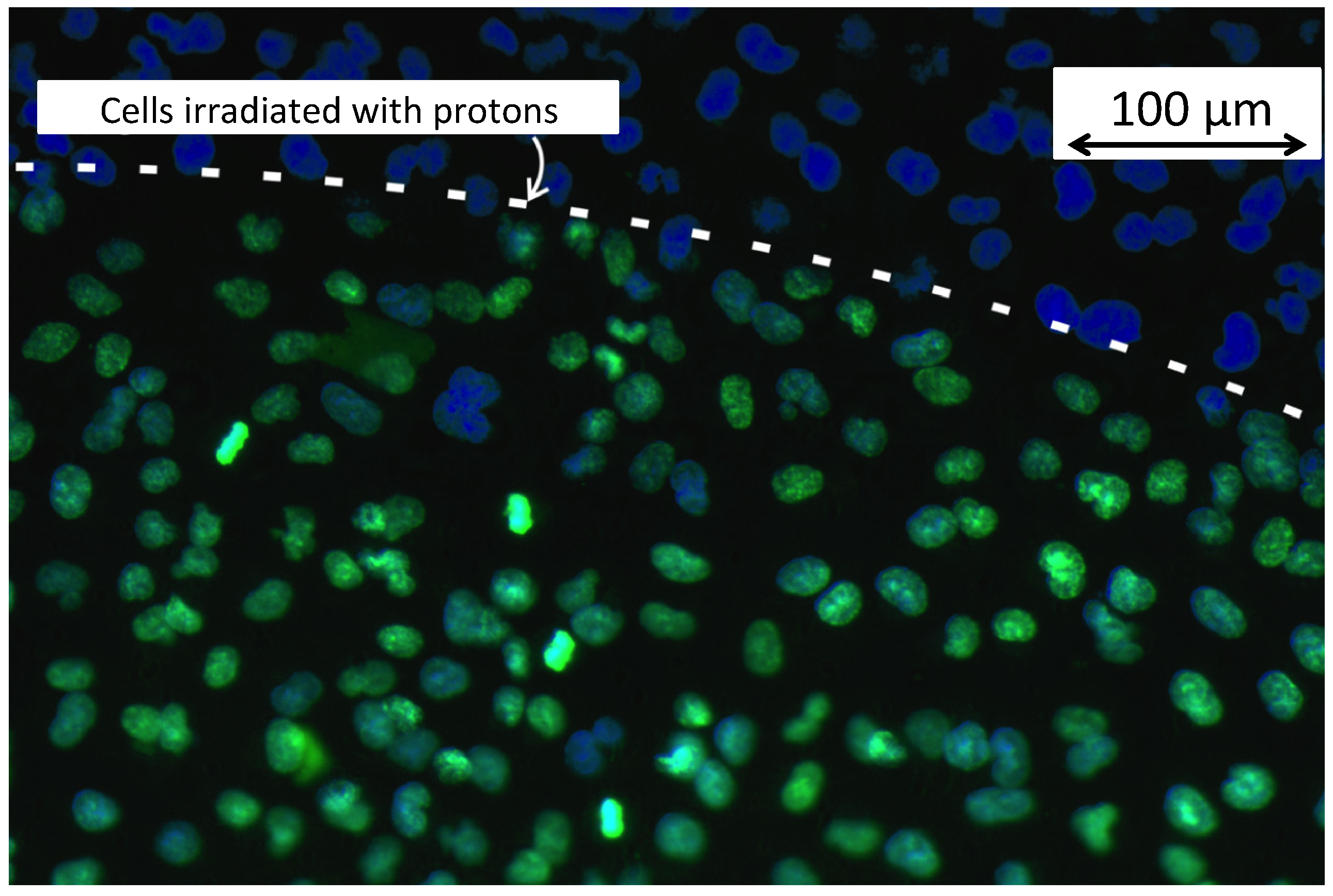
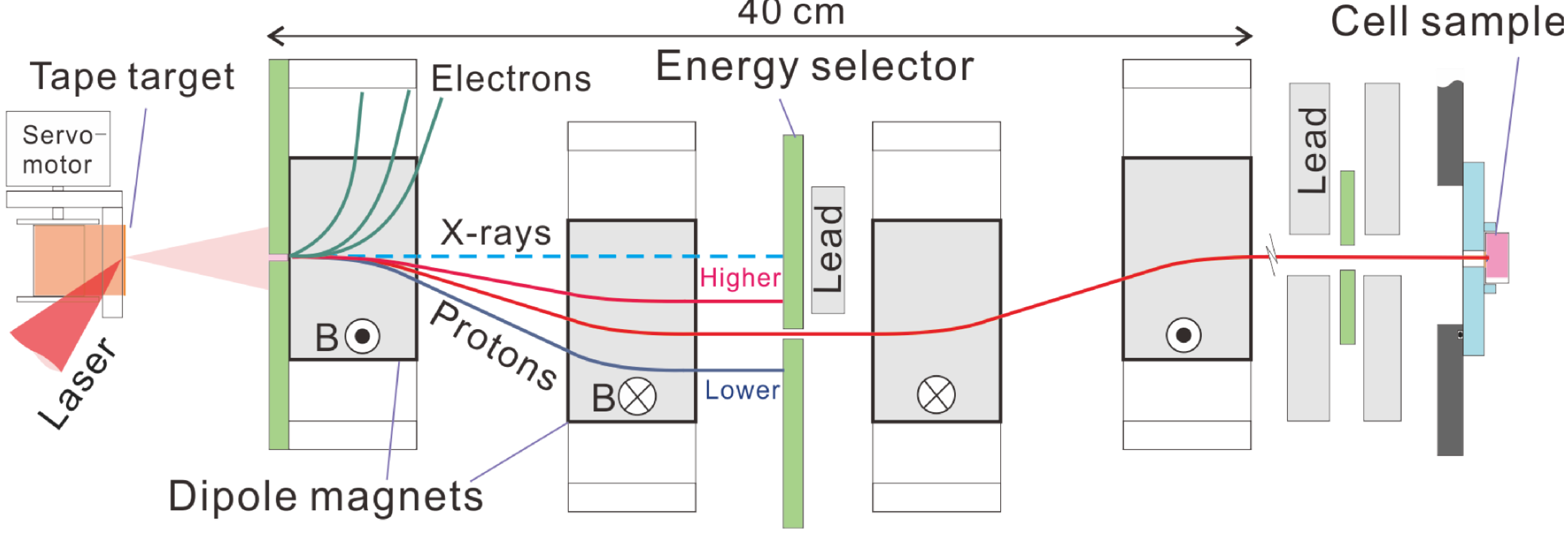
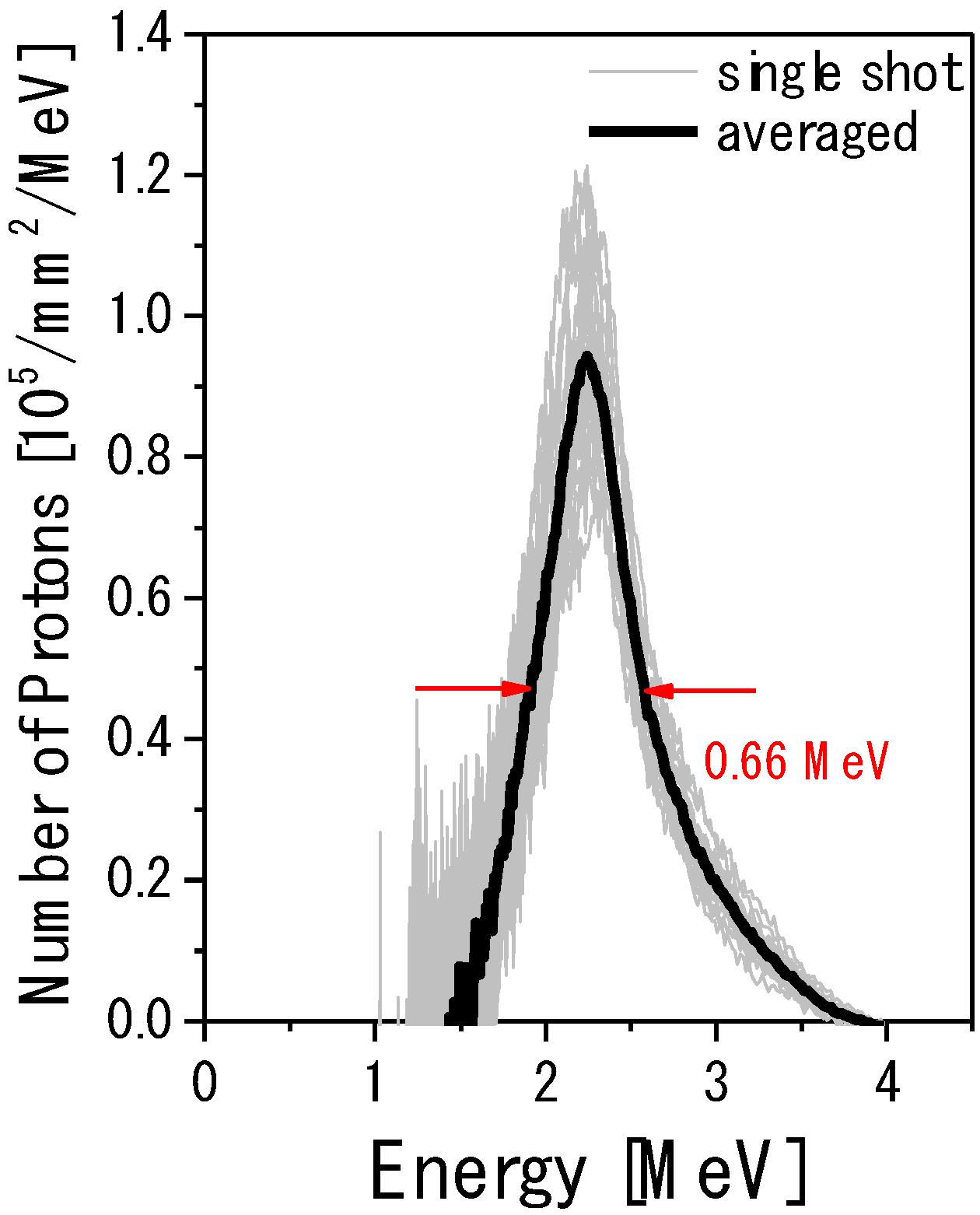
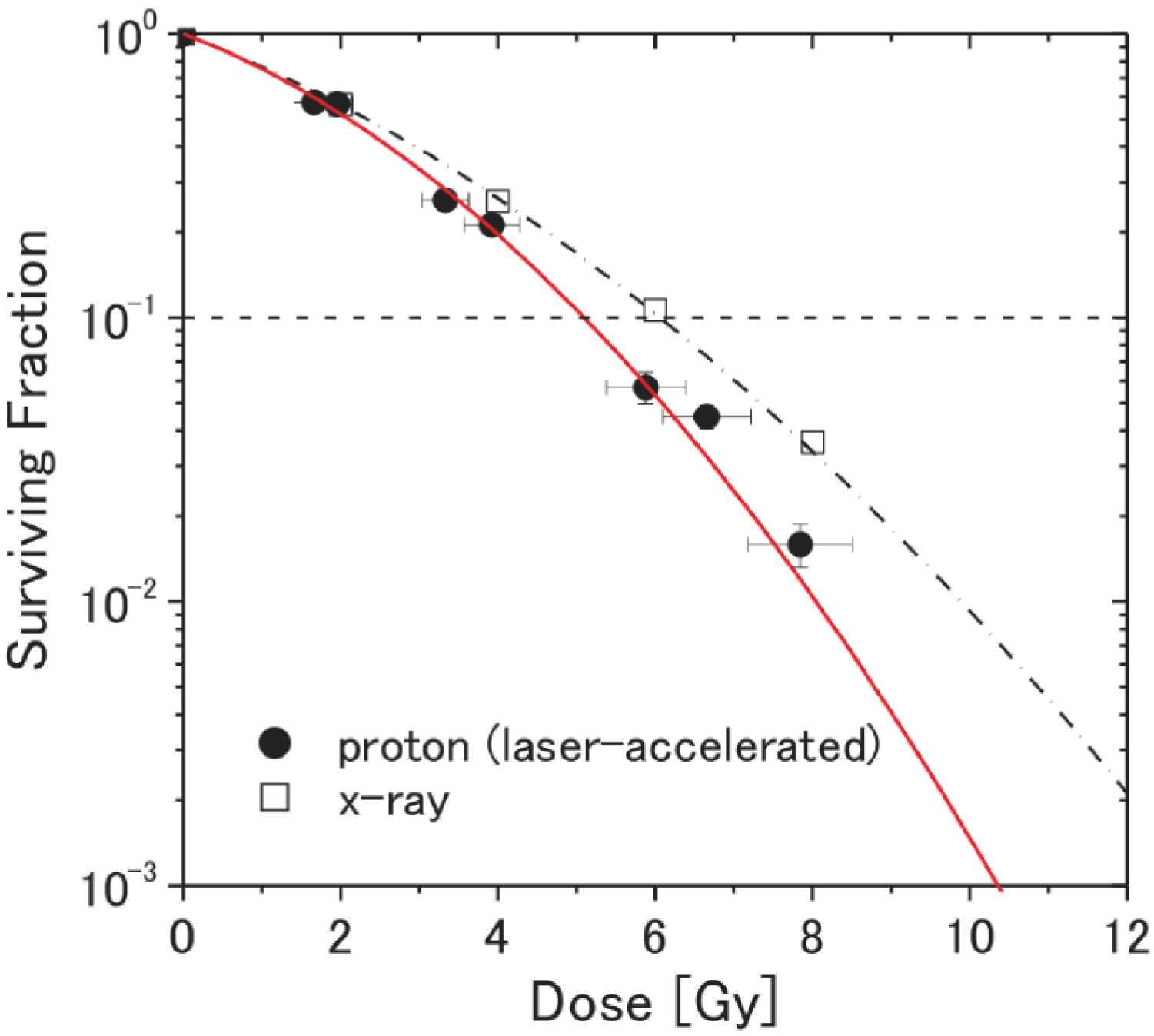
3.8. Prospects of High Field Science Experiments

 and
and  are the charge and mass of an electron, c is the speed of light,
are the charge and mass of an electron, c is the speed of light,  is Planck constant, ω and
is Planck constant, ω and  are the EM field frequency and strength, respectively,
are the EM field frequency and strength, respectively,  is the classical electron radius,
is the classical electron radius,  is the tensor of the EM field, and
is the tensor of the EM field, and  and
and  are the electron, positron and photon momentum. The first parameter, a, is the dimensionless amplitude of the EM field, and is purely classical parameter. It has a meaning of electron energy gain over a distance of λ = c/ω in units of its rest energy,
are the electron, positron and photon momentum. The first parameter, a, is the dimensionless amplitude of the EM field, and is purely classical parameter. It has a meaning of electron energy gain over a distance of λ = c/ω in units of its rest energy,  . When a is small the most probable are the processes with minimum possible number of photons. At a << 1 the probabilities become equal to the perturbation theory probabilities and plane waves represents an ensemble of individual photons. The linear regime of photon-electron (Thomson) scattering (see for example [106]) mentioned here is of a paramount importance for the generation of gamma-rays sourced for nuclear applications, both for accelerator based sources and also for laser based sources. When a ≈ 1 or a >> 1 the probabilities of absorbing different number of photons become comparable and the process becomes multiphoton, i.e., the probability has an essentially nonlinear dependence on the field. With the rapid development of laser technology EM pulses routinely obtain a >> 1. The EM pulse with the intensity corresponding to a above 30 has been generated by the J-KAREN laser system used in the experiments [19]. The second parameter εrad characterizes the radiation friction effects. At the laser field amplitude above
. When a is small the most probable are the processes with minimum possible number of photons. At a << 1 the probabilities become equal to the perturbation theory probabilities and plane waves represents an ensemble of individual photons. The linear regime of photon-electron (Thomson) scattering (see for example [106]) mentioned here is of a paramount importance for the generation of gamma-rays sourced for nuclear applications, both for accelerator based sources and also for laser based sources. When a ≈ 1 or a >> 1 the probabilities of absorbing different number of photons become comparable and the process becomes multiphoton, i.e., the probability has an essentially nonlinear dependence on the field. With the rapid development of laser technology EM pulses routinely obtain a >> 1. The EM pulse with the intensity corresponding to a above 30 has been generated by the J-KAREN laser system used in the experiments [19]. The second parameter εrad characterizes the radiation friction effects. At the laser field amplitude above  , corresponding to 1023 W/cm2, the radiation friction makes the laser-matter interaction highly dissipative. This results in the high power gamma-ray flash generation [107]. The third parameter χe has a meaning of the ratio of EM field strength in the rest frame of the particle to the critical QED field equal to
, corresponding to 1023 W/cm2, the radiation friction makes the laser-matter interaction highly dissipative. This results in the high power gamma-ray flash generation [107]. The third parameter χe has a meaning of the ratio of EM field strength in the rest frame of the particle to the critical QED field equal to

 produces a work over the Compton wavelength distance of
produces a work over the Compton wavelength distance of  equal to mec2. Parameters χe and χγ are responsible for the magnitude of the quantum nonlinear effects: when a >> 1 these effects are maximized for χe,y ≈ 1. All these processes in high intensity EM fields are part of a new emerging branch of physics.
equal to mec2. Parameters χe and χγ are responsible for the magnitude of the quantum nonlinear effects: when a >> 1 these effects are maximized for χe,y ≈ 1. All these processes in high intensity EM fields are part of a new emerging branch of physics. , χe = 0.3, and χγ =0.15) [108,109]. The modern day laser systems can produce
, χe = 0.3, and χγ =0.15) [108,109]. The modern day laser systems can produce  , and GeV-level electron beams, which not only will boost the classical and quantum nonlinearities, but also significantly reduce the characteristic scale of the process, resulting in a cascade-type multistage process in the interaction of an electron beam with an intense laser pulse.
, and GeV-level electron beams, which not only will boost the classical and quantum nonlinearities, but also significantly reduce the characteristic scale of the process, resulting in a cascade-type multistage process in the interaction of an electron beam with an intense laser pulse.| Parameters | E (150 MeV) + PWLaser | E (1.25 GeV) +PWLaser | E (10 GeV) +PWlaser |
|---|---|---|---|
| γe | 300 | 2500 | 2 × 104 |
| χe | 0.05 | 0.5 | 2.5 |
| χγ | 0.01 | 0.05 | 1 |
| αrad = (εrad γe)−1/3 | 60 | 30 | 15 |
4. Compact, High Efficiency Laser System
4.1. Diode -Pumped Yb:YAG Chirped-Pulse Amplification Laser
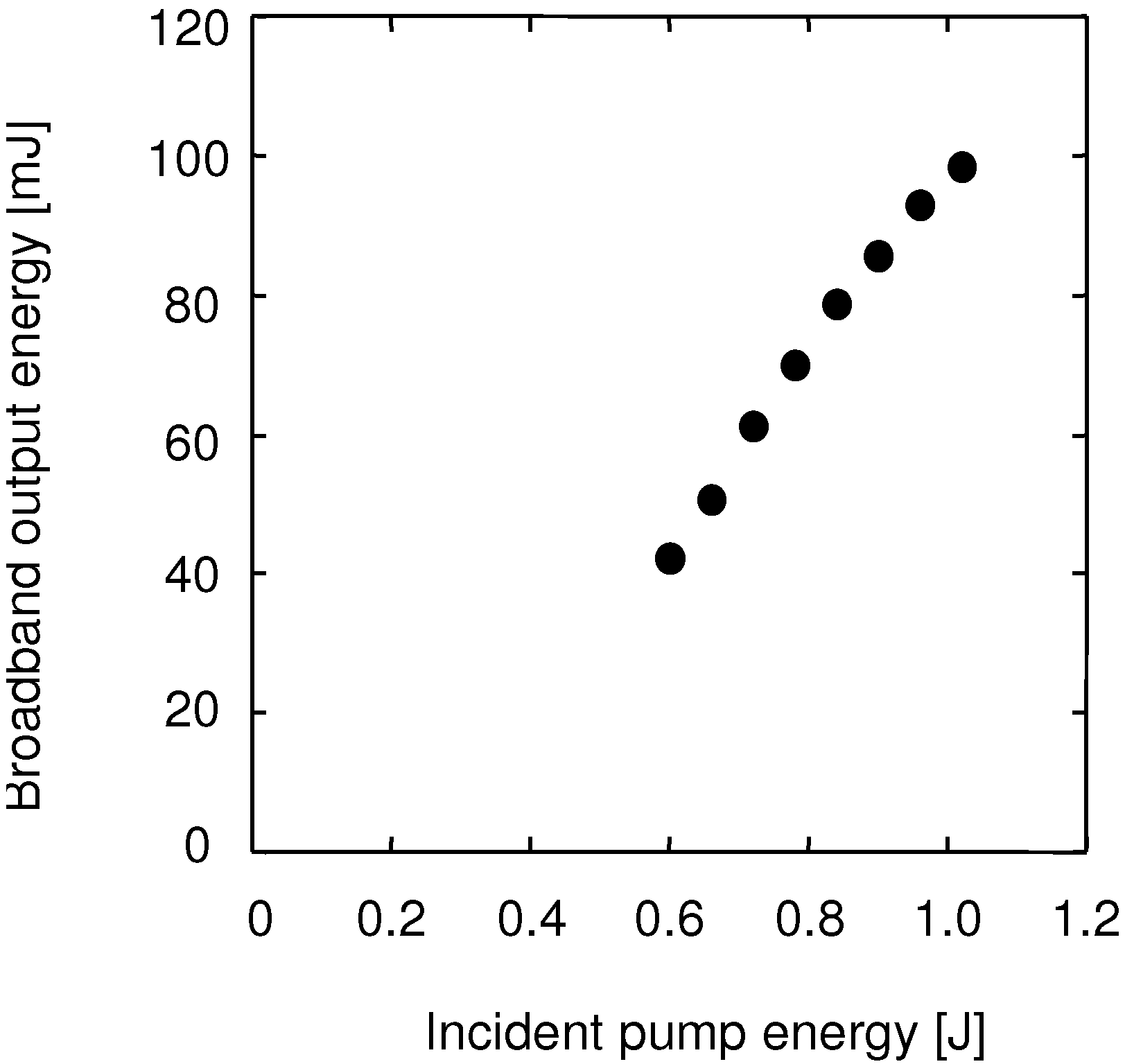
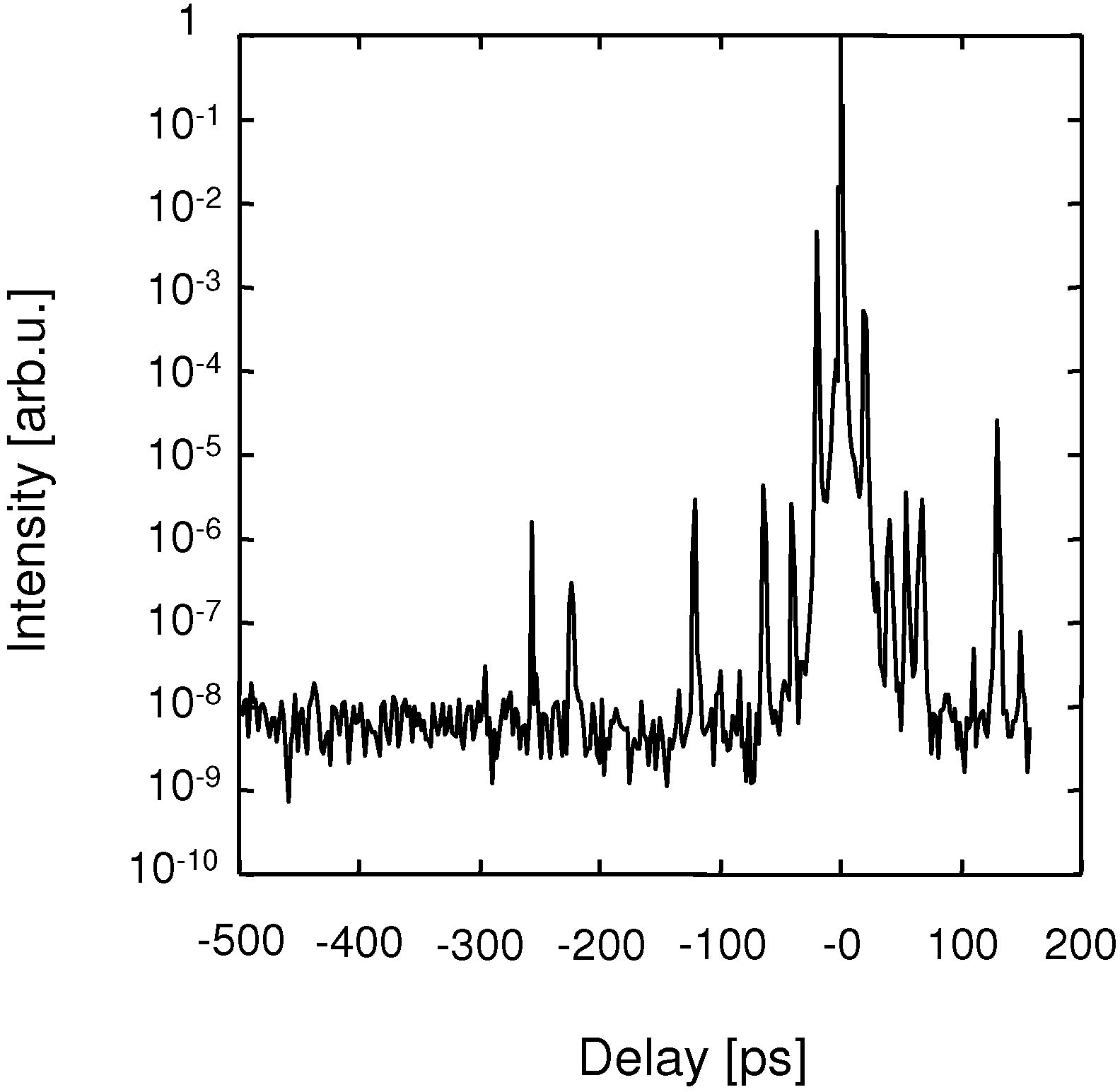
4.2. Diode -Pumped Nd-Doped Mixed Scandium Garnets Ceramic Laser
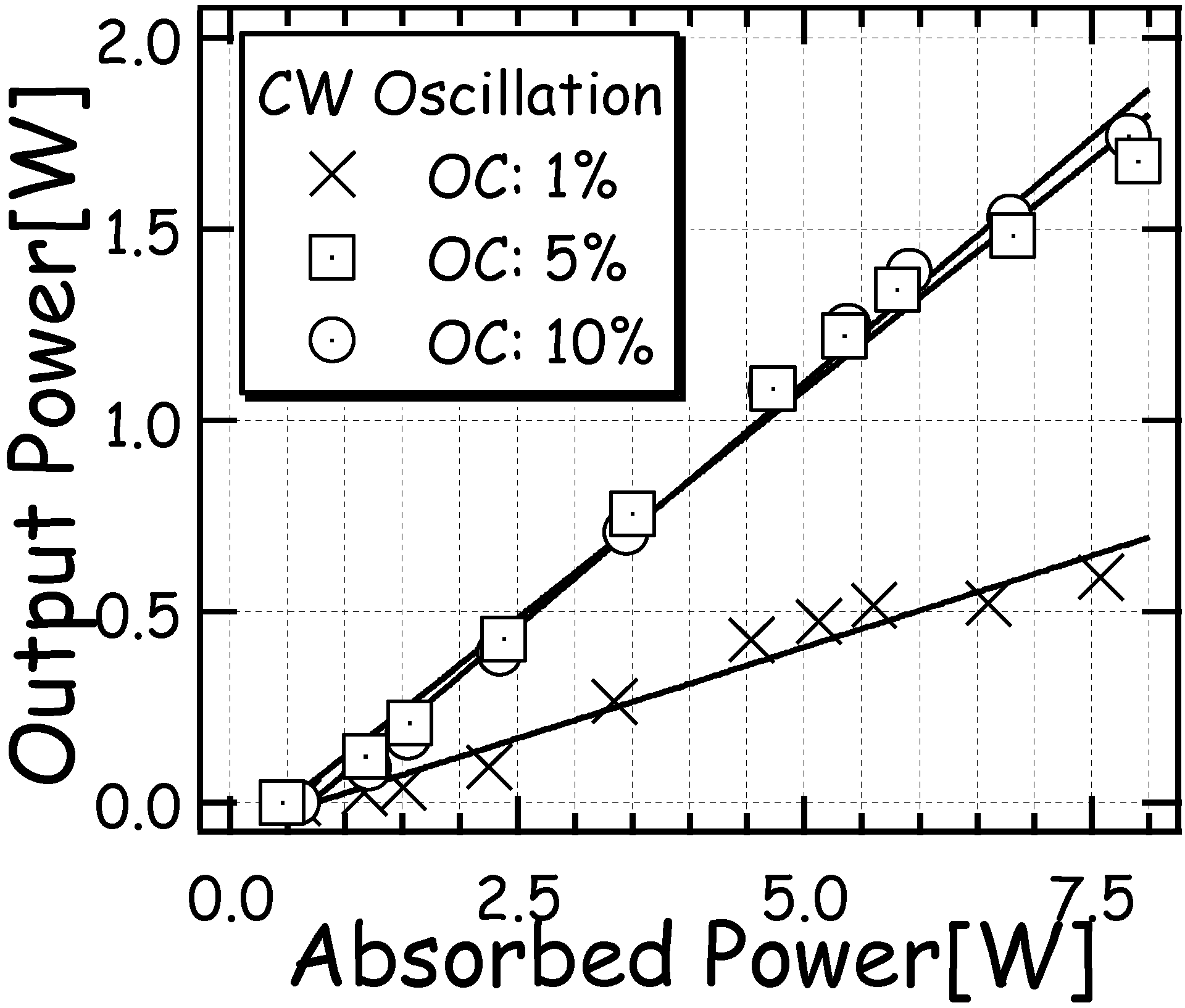
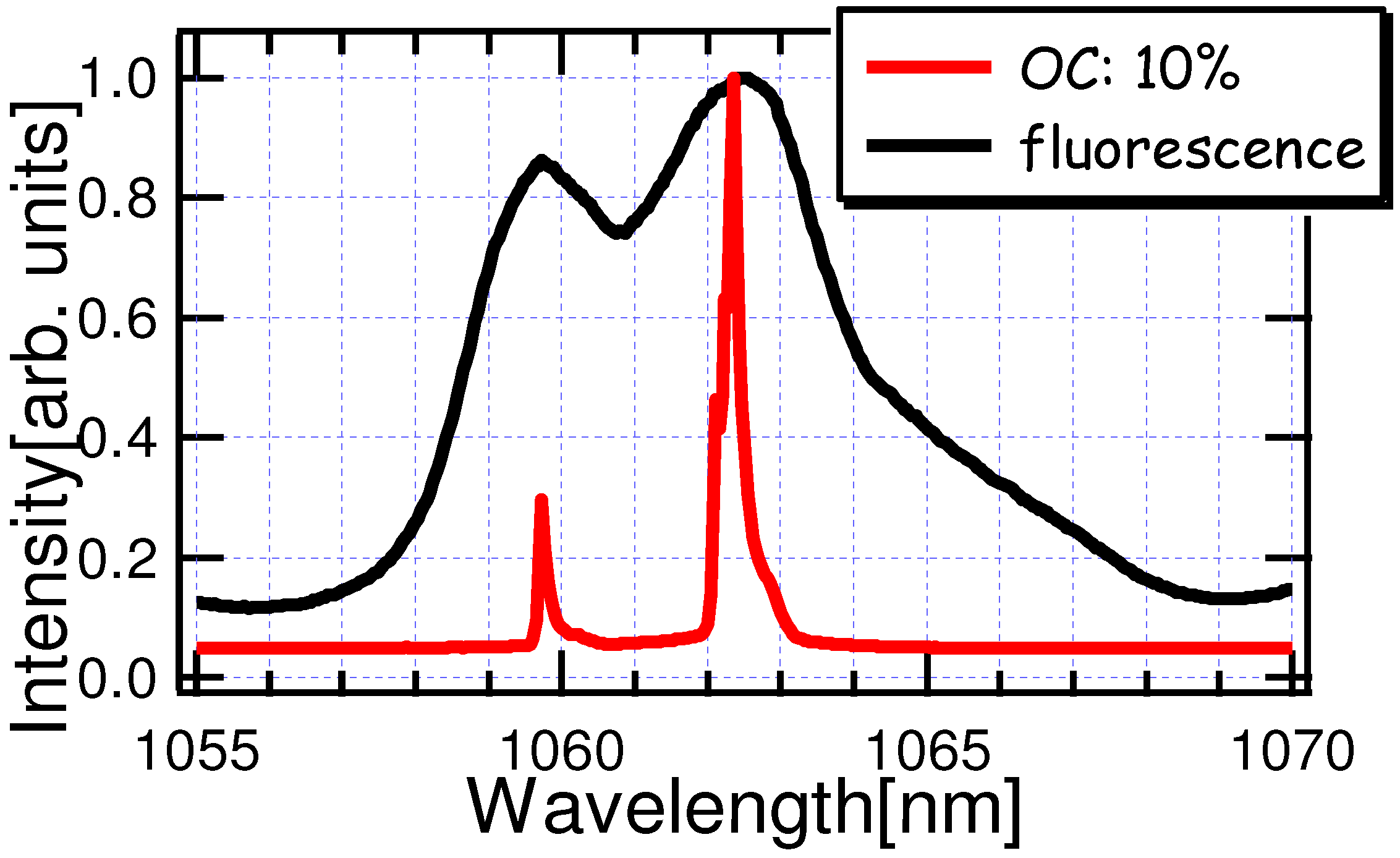
5. Conclusions
Acknowledgments
Conflict of Interest
References
- Strickland, D.; Mourou, G. Compression of amplified chirped optical pulses. Opt. Commun. 1985, 56, 219–221. [Google Scholar] [CrossRef]
- Umstadter, D. Review of physics and applications of relativistic plasmas driven by ultra-intense lasers. Phys. Plasmas 2001, 8, 1774–1785. [Google Scholar] [CrossRef]
- Ditmire, T.; Bless, S.; Dyer, G.; Edens, A.; Grigsby, W.; Hays, G.; Madison, K.; Maltsev, A.; Colvin, J.; Edwards, M.J.; et al. Overview of future directions in high energy-density and high-field science using ultra-intense lasers. Radia. Phys. Chem. 2004, 70, 535–552. [Google Scholar] [CrossRef]
- Aoyama, M.; Yamakawa, K.; Akahane, Y.; Ma, J.; Inoue, N.; Ueda, H.; Kiriyama, H. 0.85-PW, 33-fs Ti:sapphire laser. Opt. Lett. 2003, 28, 1594–1596. [Google Scholar]
- Liang, X.; Leng, Y.C.; Li, C.; Lin, L.; Zhao, B.; Jiang, Y.; Lu, X.; Hu, M.; Zhang, C.; Lu, H.; et al. Parasitic lasing suppression in high gain femtosecond petawatt Ti:sapphire amplifier. Opt. Exp. 2007, 15, 15335–15341. [Google Scholar] [CrossRef]
- Fourmaux, S.; Payeur, S.; Alexandrov, A.; Serbanescu, S.; Martin, F.; Ozaki, T.; Kudryashov, A.; Kieffer, J.C. Laser beam wavefront correction for ultra high intensities with the 200 TW laser system at the advanced laser light source. Opt. Exp. 2008, 16, 11987–11994. [Google Scholar] [CrossRef]
- Yanovsky, V.; Chvykov, V.; Kalinchenko, G.; Rousseau, P.; Planchon, T.; Matsuoka, T.; Maksimchuk, A.; Nees, J.; Cheriaux, G.; Mourou, G.; Krushelnick, K. Ultra-high intensity-300TW laser at 0.1 Hz repetition rate. Opt. Exp. 2008, 16, 2109–2114. [Google Scholar] [CrossRef]
- Sung, J.H.; Lee, S.K.; Yu, T.J.; Jeong, T.M.; Lee, J. 0.1 Hz 1.0 PW Ti:sapphire laser. Opt. Lett. 2010, 35, 3021–3023. [Google Scholar] [CrossRef]
- Wang, Z.; Liu, C.; Shen, Z.; Zhang, Q.; Teng, H.; Wei, Z. High-contrast 1.16 PW Ti:sapphire laser system combined with a doubled chirped-pulse amplification scheme and a femtosecond optical-parametric amplifier. Opt. Lett. 2011, 36, 3194–3196. [Google Scholar]
- Hooker, C.; Tang, Y.; Chekhlov, O.; Collier, J.; Divall, E.; Ertel, K.; Hawkes, S.; Parry, B.; Rajeev, P.R. Improving coherent contrast of petawatt laser pulses. Opt. Exp. 2011, 19, 2193–2203. [Google Scholar] [CrossRef]
- Kiriyama, H.; Mori, M.; Nakai, Y.; Shimomura, T.; Sasao, H.; Tanoue, M.; Kanazawa, S.; Wakai, D.; Sasao, F.; Okada, H.; et al. High temporal and spatial quality petawatt-class Ti:sapphire chirped-pulse amplification laser system. Opt. Lett. 2010, 35, 1497–1499. [Google Scholar] [CrossRef]
- Bahk, S.-W.; Rousseau, P.; Planchon, T.A.; Chvykov, V.; Kalintchenko, G.; Maksimchuk, A.; Mourou, G.A.; Yanovsky, V. Generation and characterization of the highest laser intensities (1022 W/cm2). Opt. Lett. 2004, 29, 2837–2839. [Google Scholar] [CrossRef]
- The Extreme Light Infrastructure. Available online: http://www.extreme-light-infrastructure.eu/ (accessed on 7 December 2012).
- Ceccotti, T.; Lévy, A.; Popescu, H.; Réau, F.; D’Oliveira, P.; Monot, P.; Geindre, J.P.; Lefebvre, E.; Martin, P. Proton acceleration with high-intensity ultrahigh-contrast laser pulses. Phys. Rev. Lett. 2007, 99, 185002. [Google Scholar] [CrossRef]
- Antici, P.; Fuchs, J.; d’Humières, E.; Lefebvre, E.; Borghesi, M.; Brambrink, E.; Cecchetti, C.A.; Gaillard, S.; Romagnani, L.; Sentoku, Y.; et al. Energetic protons generated by ultrahigh contrast laser pulses interacting with ultrathin targets. Phys. Plasmas 2007, 14, 030701. [Google Scholar] [CrossRef]
- Esarey, E.; Schroeder, C.B.; Leemans, W.P. Physics of laser-driven plasma-based electron accelerator. Rev. Mod. Phys. 2009, 81, 1229–1286. [Google Scholar] [CrossRef]
- Kotaki, H.; Daito, I.; Kando, M.; Hayashi, Y.; Kawase, K.; Kameshima, K.; Fukuda, Y.; Homma, T.; Ma, J.; Chen, L.-M.; et al. Electron optical injection with head-on and counter-crossing colliding laser pulses. Phys. Rev. Lett. 2009, 103, 194803. [Google Scholar] [CrossRef]
- Fukuda, Y.; Faenov, A.Y.; Tampo, M.; Pikuz, T.A.; Nakamura, T.; Kando, M.; Hayashi, Y.; Yogo, A.; Sakaki, H.; Kameshima, T.; et al. Energy increase in multi-MeV ion acceleration in the interaction of a short pulse laser with a cluster-gas target. Phys. Rev. Lett. 2009, 103, 165002. [Google Scholar] [CrossRef]
- Ogura, K.; Nishiuchi, M.; Pirozhkov, A.S.; Tanimoto, T.; Sagisaka, A.; Esirkepov, T.Z.; Kando, M.; Shizuma, T.; Hayakawa, T.; Kiriyama, H.; et al. Proton acceleration to 40 MeV using a high intensity, high contrast OPCPA/Ti:Sapphire hybrid laser system. Opt. Lett. 2012, 37, 2868–2870. [Google Scholar] [CrossRef]
- Fukuda, Y.; Sakaki, H.; Kanasaki, M.; Yogo, A.; Jinno, S.; Tampo, M.; Faenov, A.Y.; Pikuz, T.A.; Hayashi, Y.; Kando, M.; et al. Identification of high energy ions using backscattered particles in laser-driven ion acceleration with cluster-gas targets. Radiat. Meas. 2012, in press. [Google Scholar]
- Rousse, A.; Phuoc, K.T.; Shah, R.; Pukhov, A.; Lefebvre, E.; Malka, V.; Kiselev, S.; Burgy, F.; Rousseau, J.-P.; Umstadter, D.; et al. Production of a keV X-ray bean from synchrotron radiation in relativistic laser-plasma interaction. Phys. Rev. Lett. 2004, 93, 135005. [Google Scholar] [CrossRef]
- Kando, M.; Fukuda, Y.; Pirozhkov, A.S.; Ma, J.; Daito, I.; Chen, L.-M.; Esirkepov, T.Z.; Ogura, K.; Homma, T.; Hayashi, Y.; et al. Demonstration of laser-frequency upshift by electron-density modulations in a plasma wakefield. Phys. Rev. Lett. 2007, 99, 135001. [Google Scholar] [CrossRef]
- Fukuda, Y.; Faenov, A.Y.; Pikuz, T.; Kando, M.; Kotaki, H.; Daito, I.; Ma, J.; Chen, L.M.; Homma, T.; Kawase, K.; et al. Soft X-ray source for nanostructure imaging using femtosecond-laser-irradiated clusters. Appl. Phys. Lett. 2008, 92, 121110. [Google Scholar] [CrossRef]
- Hayashi, Y.; Pirozhkov, A.S.; Kando, M.; Fukuda, Y.; Faenov, A.; Kawase, K.; Pikuz, T.; Nakamura, T.; Kiriyama, H.; Okada, H.; et al. Efficient generation of Xe K-shell X rays by high-contrast interaction with submicrometer clusters. Opt. Lett. 2011, 36, 1614–1616. [Google Scholar] [CrossRef]
- Pirozhkov, A.S.; Kando, M.; Esirkepov, T.Z.; Gallegos, P.; Ahmed, H.; Ragozin, E.N.; Faenov, A.Y.; Pikuz, T.A.; Kawachi, T.; Sagisaka, A.; et al. Soft X-ray harmonic comb from relativistic electron spikes. Phys. Rev. Lett. 2012, 108, 135004. [Google Scholar] [CrossRef]
- Zhang, Z.; Nishimura, H.; Namimoto, T.; Fujioka, S.; Arikawa, Y.; Nishikino, M.; Kawachi, T.; Sagisaka, A.; Hosoda, H.; Orimo, S.; et al. Quantitative measurement of hard X-ray spectra for high intensity laser produced plasma. Rev. Sci. Instrum. 2012, 85, 53502. [Google Scholar]
- Faenov, A.F.; Skobelev, I.Y.; Pikuz, T.A.; Pikuz, S.A.; Fortov, V.E.; Fukuda, Y.; Hayashi, Y.; Pirozhkov, A.; Kotaki, H.; Shimomura, T.; et al. X-ray spectroscopy diagnoses of clusters surviving under prepulses of ultraintense femtosecond laser pulse irradiation. Laser Part. Beams. 2012, 30, 481–488. [Google Scholar] [CrossRef]
- Ogura, K.; Shizuma, T.; Hayakawa, T.; Yogo, A.; Nishiuchi, M.; Orimo, S.; Sagisaka, A.; Pirozhkov, A.; Mori, M.; Kiriyama, H.; et al. Proton-induced nuclear reactions using compact high-contrast high-intensity laser. Appl. Phys. Exp. 2009, 2, 066001. [Google Scholar] [CrossRef]
- Ogura, K.; Shizuma, T.; Hayakawa, T.; Yogo, A.; Nishiuchi, M.; Orimo, S.; Sagisaka, A.; Pirozhkov, A.; Mori, M.; Kiriyama, H.; et al. Complementary characterization of radioactivity produced by repetitive laser-driven proton beam using shot-to-shot proton spectral measurement and direct activation measurement. Jpn. J. Appl. Phys. 2012, 51, 048003. [Google Scholar] [CrossRef]
- Dromey, B.; Zepf, M.; Gopal, A.; Lancaster, K.; Wei, M.S.; Krusheknick, K.; Tatarakis, M.; Vakakis, N.; Moustaizis, S.; Kodama, R.; et al. High harmonic generation in the relativistic limit. Nat. Phys. 2006, 2, 456–459. [Google Scholar] [CrossRef]
- Neely, D.; Foster, P.; Robinson, A.; Lindau, F.; Lundh, O.; Persson, A.; Wahlström, C.G.; McKenna, P. Enhanced proton beams from ultrathin targets driven by high contrast laser pulse. Appl. Phys. Lett. 2006, 89, 021502. [Google Scholar] [CrossRef]
- Minkovski, N.; Petrov, G.I.; Saltiel, S.M.; Albert, O.; Etchepare, J. Nonlinear polarization rotation and orthogonal polarization generation experienced in a single-beam configuration. J. Opt. Soc. Am. B 2004, 21, 1659–1664. [Google Scholar]
- Jullien, A.; Albert, O.; Burgy, F.; Hamoniaux, G.; Rousseau, J.P.; Chambaret, J.P.; Augé-Rochereau, F.; Chériaux, G.; Etchepare, J.; Minkovski, N.; et al. 10−10 temporal contrast for femtosecond ultraintense lasers by crosspolarized wave generation. Opt. Lett. 2005, 30, 920–922. [Google Scholar] [CrossRef]
- Itatani, J.; Faure, J.; Nantel, M.; Mourou, G.; Watanabe, S. Suppression of the amplifiedspontaneous emissionin chirpedpulse-amplification lasers by clean high-energy seed-pulse injection. Opt. Commun. 1998, 148, 70–74. [Google Scholar] [CrossRef]
- Kiriyama, H.; Mori, M.; Nakai, Y.; Shimomura, T.; Tanoue, M.; Akutsu, A.; Okada, H.; Motomura, T.; Kondo, S.; Kanazawa, S.; et al. Generation of high-contrast and high-intensity laser pulses using an OPCPA preamplifier in a double CPA, Ti:sapphire laser system. Opt. Commun. 2009, 282, 625–628. [Google Scholar] [CrossRef]
- Dromey, B.; Kar, S.; Zepf, M.; Foster, P. The plasma mirror—A subpicosecond optical switch for ultrahigh power lasers. Rev. Sci. Instrum. 2004, 75, 645–649. [Google Scholar] [CrossRef]
- Taur, C.; Quéré, F.; Geindre, J.-P.; Levy, A.; Ceccotti, T.; Monot, P.; Bougeard, M.; Réau, F.; D’oliveira, P.; Audebert, P.; et al. Plasma mirrors for ultrahighintensity optics. Nat. Phys. 2007, 3, 424–429. [Google Scholar] [CrossRef]
- Liu, J.; Okamura, K.; Kida, Y.; Kobayashi, T. Temporal contrast enhancement of femtosecond pulses by a self-diffraction process in a bulk Kerr medium. Opt. Exp. 2010, 18, 22245–22254. [Google Scholar] [CrossRef]
- Chvykov, V.; Rousseau, P.; Reed, S.; Kalinchenko, G.; Yanovsky, V. Generation of 1011 contrast 50 TW laser pulses. Opt. Lett. 2006, 31, 1456–1458. [Google Scholar] [CrossRef]
- Wittmann, T.; Geindre, J.P.; Audebert, P.; Marjoribanks, R.S.; Rousseau, J.P.; Burgy, F.; Douillet, D.; Lefrou, T.; Phuoc, K.T.; Chambaret, J.P. Towards ultrahigh-contrast ultraintense laser pulses—Complete characterization of a double plasma-mirror pulse cleaner. Rev. Sci. Instrum. 2006, 77, 083109. [Google Scholar] [CrossRef]
- Kim, I.J.; Choi, I.W.; Lee, S.K.; Janulewicz, K.A.; Sung, J.H.; Yu, T.J.; Kim, H.T.; Yun, H.; Jeong, T.M.; Lee, J. Spatio-Temporal characterization of double plasma mirror for ultrahigh contrast and stable laser pulse. Appl. Phys. B 2011, 104, 81–86. [Google Scholar] [CrossRef]
- Dubietis, A.; Jonusauskas, G.; Piskarskas, A. Powerful femtosecond pulse generation by chirped and stretched pulse parametric amplification in BBO crystal. Opt. Commun. 1992, 88, 437–440. [Google Scholar] [CrossRef]
- Ross, I.N.; Matousek, P.; Towrie, M.; Langley, A.J.; Collier, J.L. The prospects for ultrashort pulse duration and ultrahigh intensity using optical parametric chirped pulse amplifiers. Opt. Commun. 1997, 144, 125–133. [Google Scholar] [CrossRef]
- Kitagawa, Y.; Fujita, H.; Kodama, R.; Yoshida, H.; Matsuo, S.; Jitsuno, T.; Kawasaki, T.; Kitamura, H.; Kanabe, T.; Sakabe, S.; et al. Prepulse-free petawatt laser for a fast ignitor. IEEE J. Quantum Electron. 2004, 40, 281–293. [Google Scholar] [CrossRef]
- Musgrave, I.O.; Hernandez-Gomez, C.; Canny, D.; Collier, J.; Heathcote, R. Minimization of the impact of a broad bandwidth high-gain nonlinear preamplifier to the amplified spontaneous emission pedestal of the Vulcan petawatt laser facility. Appl. Opt. 2007, 46, 6978–6983. [Google Scholar] [CrossRef]
- Blanchot, N.; Behar, G.; Berthier, T.; Bignon, E.; Boubault, F.; Chappuis, C.; Coïc, H.; Damiens-Dupont, C.; Ebrardt, J.; Gautheron, Y.; et al. Overview of PETAL, multi-petawatt project on the LIL facility. Plasma Phys. Controlled Fusion 2008, 50, 124045. [Google Scholar] [CrossRef]
- Schwarz, J.; Rambo, P.; Geissel, M.; Kimmel, M.; Brambrink, E.; Atherton, B.; Glassman, J. A hybrid OPCPA/Nd:phosphate glass multi-terawatt laser system for seeding of a petawatt laser. Opt. Commun. 2008, 281, 4984–4992. [Google Scholar] [CrossRef]
- Ple, F.; Pittman, M.; Jamelot, G.; Chambaret, J.P. Design and demonstration of a high-energy booster amplifier for a high-repetition rate petawatt class laser system. Opt. Lett. 2007, 32, 238–240. [Google Scholar] [CrossRef]
- Ertel, K.; Hooker, C.; Hawkes, S.J.; Parry, B.T.; Collier, J.L. ASE suppression in a high energy titanium sapphire amplifier. Opt. Exp. 2008, 16, 8039–8049. [Google Scholar]
- Fourmaux, S.; Payeur, S.; Buffechoux, S.; Lassonde, P.; St Pierre, C.; Martin, F.; Kieffer, J.C. Pedestal cleaning for high laser pulse contrast ratio with a 100 TW class laser system. Opt. Exp. 2011, 19, 8486–8497. [Google Scholar]
- Hong, K.H.; Hou, B.; Nees, J.A.; Power, E.; Mourou, G.A. Generation and measurement of >108 intensity contrast ratio in a relativistic kHz chirped-pulse amplified laser. Appl. Phys. B 2005, 81, 447–457. [Google Scholar] [CrossRef]
- Cheriaux, G.; Rousseau, P.; Salin, F.; Chambaret, J.P.; Walker, B.; Dimauro, L.F. Aberration-free stretcher design for ultrashort-pulse amplification. Opt. Lett. 1996, 21, 414–416. [Google Scholar] [CrossRef]
- Tavella, F.; Marcinkevicius, A.; Krausz, F. Investigation of the superfluorescence and signal amplification in an ultrabroadband multiterawatt optical parametric chirped pulse amplifier system. New J. Phys. 2006, 8, 219. [Google Scholar] [CrossRef]
- Okada, H.; Kiriyama, H.; Mori, M.; Nakai, Y.; Shimomura, T.; Tanoue, M.; Kondo, S.; Kanazawa, S.; Daido, H.; Kimura, T.; et al. Demonstration of highly efficient broadband amplification in an optical parametric chirped-pulse amplifier system. Opt. Rev. 2009, 16, 1–3. [Google Scholar] [CrossRef]
- Shah, R.C.; Johnson, R.P.; Shimada, T.; Flippo, K.A.; Fernandez, J.C.; Hegelich, B.M. High-Temporal contrast using low-gain optical parametric amplification. Opt. Lett. 2009, 34, 2273–2275. [Google Scholar]
- Kiriyama, H.; Mori, M.; Nakai, Y.; Yamamoto, Y.; Tanoue, M.; Akutsu, A.; Shimomura, T.; Kondo, S.; Kanazawa, S.; Daido, H.; et al. High-energy, high-contrast, multiterawatt laser pulses by optical parametric chirped-pulse amplification. Opt. Lett. 2007, 32, 2315–2317. [Google Scholar] [CrossRef]
- Bagnoud, V.; Begishev, I.A.; Guardalben, M.J.; Puth, J.; Zuegel, J.D. 5 Hz, >250 mJ optical parametric chirped-pulse amplifier at 1053 nm. Opt. Lett. 2005, 30, 1843–1845. [Google Scholar]
- Wnuk, P.; Stepanenko, Y.; Radzewicz, C. Multi-terawatt chirped pulse optical parametric amplifier with a time-shear power amplification stage. Opt. Exp. 2009, 17, 15264–15273. [Google Scholar]
- Chekhlov, O.V.; Collier, J.L.; Ross, I.N.; Bates, P.K.; Notley, M.; Hernandez-Gomez, C.; Shaikh, W.; Danson, C.N.; Neely, D.; Matousek, P.; et al. 35 J broadband femtosecond optical parametric chirped pulse amplification system. Opt.Lett. 2006, 31, 3665–3667. [Google Scholar] [CrossRef]
- Suzuki, M.; Kiriyama, H.; Daito, I.; Okada, H.; Nakai, Y.; Orimo, S.; Sato, M.; Tamaoki, Y.; Yoshii, T.; Maeda, J.; et al. Multimillijoule, nonlinear preamplifier for high intensity femtosecond Yb:YAG chirped-pulse amplification lasers at 1030 nm. Appl. Phys. B 2009, 97, 379–382. [Google Scholar] [CrossRef]
- Kiriyama, H.; Inoue, N.; Akahane, Y.; Yamakawa, K. Prepulse-Free, multi-terawatt, sub-30 fs laser system. Opt. Exp. 2006, 14, 438–445. [Google Scholar] [CrossRef]
- Pittman, M.; Ferré, S.; Rousseau, J.P.; Notebaert, L.; Chambaret, J.P.; Chériaux, G. Design and characterization of a near-diffraction-limited femtosecond 100 TW 10 Hz high-intensity laser system. Appl. Phys. B 2002, 74, 529–535. [Google Scholar] [CrossRef]
- Kiriyama, H.; Mori, M.; Nakai, Y.; Shimomura, T.; Tanoue, M.; Akutsu, A.; Kondo, S.; Kanazawa, S.; Okada, H.; Motomura, T.; et al. High-Contrast, highintensity laser pulse generation using a nonlinear preamplifier in a Ti:sapphire laser system. Opt. Lett. 2008, 33, 645–647. [Google Scholar] [CrossRef]
- Planchon, T.A.; Amir, W.; Childress, C.; Squier, J.A.; Durfee, C.G. Measurement of pump-induced transient lensing in a cryogenically-cooled high average power Ti:sapphire amplifier. Opt. Exp. 2008, 16, 18557–18564. [Google Scholar]
- Eimerl, D. Quadrature frequency conversion. IEEE J. Quantum Electron. 1987, 23, 1361–1371. [Google Scholar] [CrossRef]
- Kiriyama, H.; Nakano, F.; Yamakawa, K. High-efficiency frequency doubling of a Nd:YAG laser in a two-pass quadrature frequency-conversion scheme using CsLiB6O10 crystals. J. Opt. Soc. Am. B 2002, 19, 1857–1864. [Google Scholar] [CrossRef]
- Tanaka, M.; Kiriyama, H.; Ochi, Y.; Nakai, Y.; Sasao, H.; Okada, H.; Daido, H.; Bolton, P.; Kawanishi, S. High-energy, spatially flat-top green pump laser by beam homogenization for petawatt scale Ti:sapphire laser systems. Opt. Commun. 2009, 282, 4401–4403. [Google Scholar] [CrossRef]
- Kiriyama, H.; Tanaka, M.; Ochi, Y.; Nakai, Y.; Sasao, H.; Okada, H.; Mori, M.; Shimomura, T.; Kanazawa, S.; Daido, H.; et al. 100 J level green laser beam homogenization to pump a petawatt class Ti:sapphire chirped-pulse amplification laser system. Rev. Laser Eng. 2009, 37, 467–469. [Google Scholar]
- Frantz, L.M.; Nodvik, J.S. Theory of pulse propagation in a laser amplifier. J. Appl. Phys. 1963, 34, 2346–2349. [Google Scholar] [CrossRef]
- Borghesi, M.; Fuchs, J.; Bulanov, S.V.; MacKinnon, A.J.; Patel, P.K.; Roth, M. Fast ion generation by high-intensity laser irradiation of solid targets and applications. Fus. Sci. Technol. 2006, 49, 412–439. [Google Scholar]
- Daido, H.; Nishiuchi, M.; Pirozhkov, A.S. Review of laser-driven ion sources and their applications. Rep. Prog. Phys. 2012, 75, 056401. [Google Scholar] [CrossRef]
- Bulanov, S.V.; Khoroshkov, V.S. Feasibility of using laser ion accelerators in proton therapy. Plasma Phys. Rep. 2002, 28, 453–456. [Google Scholar] [CrossRef]
- Fourkal, E.; Shahine, B.; Ding, M.; Li, J.S.; Tajima, T.; Ma, C.M. Particle in cell simulation of laser-accelerated proton beams for radiation therapy. Med. Phys. 2002, 29, 2788–2798. [Google Scholar] [CrossRef]
- Malka, V.; Fritzler, S.; Lefebvre, E.; d'Humières, E.; Ferrand, R.; Grillon, G.; Albaret, C.; Meyroneinc, S.; Chambaret, J.P.; Antonetti, A.; et al. Practicability of protontherapy using compact laser systems. Med. Phys. 2004, 31, 1587–1592. [Google Scholar] [CrossRef]
- Hatchett, S.P.; Brown, C.G.; Cowan, T.E.; Henry, E.A.; Johnson, J.S.; Key, M.H.; Koch, J.A.; Langdon, A.B.; Lasinski, B.F.; Lee, R.W.; et al. Electron, photon, and ion beams from the relativistic interaction of Petawatt laser pulses with solid targets. Phys. Plasmas 2000, 7, 2076–2082. [Google Scholar] [CrossRef]
- Mackinnon, A.J.; Sentoku, Y.; Patel, P.K.; Price, D.W.; Hatchett, S.; Key, M.H.; Andersen, C.; Snavely, R.; Freeman, R.R. Enhancement of proton acceleration by hot-electron recirculation in thin foils irradiated by ultraintense laser pulses. Phys. Rev. Lett. 2002, 88, 215006. [Google Scholar] [CrossRef]
- Wilks, S.C.; Kruer, W.L.; Tabak, M.; Langdon, A.B. Absorption of ultra-intense laser pulses. Phys. Rev. Lett. 2002, 69, 1383–1386. [Google Scholar]
- Passoni, M.; Lontano, M. Theory of light-ion acceleration driven by a strong charge separation. Phys. Rev. Lett. 2008, 101, 115001. [Google Scholar] [CrossRef]
- Kanasaki, M.; Fukuda, Y.; Sakaki, H.; Hori, T.; Tampo, M.; Kondo, K.; Kurashima, S.; Kamiya, T.; Oda, K.; Yamauchi, T. The diagnosis method for high-energy ion beams using backscattered particles for laser-driven ion acceleration experiments. Jpn. J. Appl. Phys. 2012, 51, 056401. [Google Scholar] [CrossRef]
- Tajima, T.; Dawson, J.M. Laser electron accelerator. Phys. Rev. Lett. 1979, 43, 267–270. [Google Scholar] [CrossRef]
- Esarey, E.; Hubbard, R.F.; Leemans, W.P.; Ting, A.; Sprangle, P. Electron injection into plasma wakefields by colliding laser pulses. Phys. Rev. Lett. 1997, 79, 2682–2685. [Google Scholar]
- Kotaki, H.; Masuda, S.; Kando, M.; Koga, J.K.; Nakajima, K. Head-On injection of a high quality electron beam by the interaction of two laser pulses. Phys. Plasmas 2004, 11, 3296–3302. [Google Scholar] [CrossRef]
- Fubiani, G.; Esarey, E.; Schroeder, C.B.; Leemans, W.P. Beat wave injection of electrons into plasma waves using two interfering laser pulses. Phys. Rev. E 2004, 70, 016402. [Google Scholar] [CrossRef]
- Faure, J.; Rechatin, C.; Norlin, A.; Lifschitz, A.; Glinec, Y.; Malka, V. Controlled injection and acceleration of electrons in plasma wakefields by colliding laser pulses. Nature 2006, 444, 737–739. [Google Scholar]
- Bulanov, S.V.; Esirkepov, T.; Tajima, T. Light intensification towards the schwinger limit. Phys. Rev. Lett. 2003, 91, 085001. [Google Scholar] [CrossRef]
- Pirozhkov, A.S.; Ma, J.; Kando, M.; Esirkepov, T.Z.; Fukuda, Y.; Chen, L.-M.; Daito, I.; Ogura, K.; Homma, T.; Hayashi, Y.; et al. Frequency multiplication of light back-reflected from a relativistic wake wave. Phys. Plasmas 2007, 14, 123106. [Google Scholar] [CrossRef]
- Kando, M.; Pirozhkov, A.S.; Kawase, K.; Esirkepov, T.Z.; Fukuda, Y.; Kiriyama, H.; Okada, H.; Daito, I.; Kameshima, T.; Hayashi, Y.; et al. Enhancement of photon number reflected by the relativistic flying mirror. Phys. Rev. Lett. 2009, 103, 235003. [Google Scholar] [CrossRef]
- Dorchies, F.; Blasco, F.; Bonté, C.; Caillaud, T.; Fourment, C.; Peyrusse, O. Observation of subpicosecond X-ray emission from laser-cluster interaction. Phys. Rev. Lett. 2008, 100, 205002. [Google Scholar]
- Pirozhkov, A.S.; Kando, M.; Esirkepov, T.Zh.; Ragozin, E.N.; Faenov, A.Y.; Pikuz, T.A.; Kawachi, T.; Sagisaka, A.; Mori, M.; Kawase, K.; et al. X-ray harmonic comb from relativistic electron spikes. Available online: http://arxiv.org/abs/1004.4514 (accessed on 26 April 2010).
- Mourou, G.A.; Tajima, T.; Bulanov, S.V. Optics in the relativistic regime. Rev. Mod. Phys. 2006, 78, 309–371. [Google Scholar] [CrossRef]
- Hooker, C.J.; Blake, S.; Chekhlov, O.; Clarke, R.J.; Collier, J.L.; Divall, E.J.; Ertel, K.; Foster, P.S.; Hawkes, S.J.; Holligan, P.; et al. Commissioning the Astra Gemini Petawatt Ti:Sapphire Laser System. In Proceedings of Conference on Lasers and Electro-Optics/Quantum Electronics and Laser Science Conference and Photonic Applications Systems Technologies, San Jose, California, USA, 4–9 May 2008; Optical Society of America: Washington, DC, USA, 2008. [Google Scholar]
- Esirkepov, T.Z. Exact charge conservation scheme for Particle-in-Cell simulation with an arbitrary form-factor. Comput. Phys. Comm. 2001, 135, 144–153. [Google Scholar] [CrossRef]
- Arnold, V.I. Catastrophe Theory, 3rd ed; Springer-Verlag: Berlin, Germany, 1992. [Google Scholar]
- Poston, T.; Stewart, I. Catastrophe Theory and Its Applications; Publisher: Mineola, NY, USA, 1996. [Google Scholar]
- Esirkepov, T.Zh.; Kato, Y.; Bulanov, S.V. Bow wave from ultraintense electromagnetic pulses in plasmas. Phys. Rev. Lett. 2008, 101, 265001. [Google Scholar] [CrossRef]
- Wilson, R.R. Radiological use of fast protons. Radiology 1946, 47, 487–491. [Google Scholar]
- Bulanov, S.V.; Esirkepov, T.Z.; Khoroshkov, V.S.; Kuznetsov, A.V.; Pegoraro, F. Oncological hadrontherapy with laser ion accelerators. Phys. Lett. A 2002, 299, 240–247. [Google Scholar] [CrossRef]
- Yogo, A.; Sato, K.; Nishikino, M.; Mori, M.; Teshima, T.; Numasaki, H.; Murakami, M.; Demizu, Y.; Akagi, S.; Nagayama, S.; et al. Application of laser-accelerated protons to the demonstration of DNA double-strand breaks in human cancer cells. Appl. Phys. Lett. 2009, 94, 181502. [Google Scholar] [CrossRef]
- Yogo, A.; Sato, K.; Nishikino, M.; Maeda, T.; Sakaki, H.; Hori, T.; Ogura, K.; Nishiuchi, M.; Teshima, T.; Nishimura, H.; et al. Measurement of DNA double-strand break yield in human cancer cells by high-current, short-duration bunches of laser-accelerated protons. Jpn. J. Appl. Phys. 2011, 50, 106401. [Google Scholar] [CrossRef]
- Yogo, A.; Maeda, T.; Hori, T.; Sakaki, H.; Ogura, K.; Nishiuchi, M.; Sagisaka, A.; Kiriyama, H.; Okada, H.; Kanazawa, S.; et al. Measurement of relative biological effectiveness of protons in human cancer cells using a laser-driven quasimonoenergetic proton beamline. Appl. Phys. Lett. 2011, 98, 053701. [Google Scholar] [CrossRef]
- Nakamura, S.; Iwashita, Y.; Noda, A.; Shirai, T.; Tongu, H.; Fukumi, A.; Kado, M.; Yogo, A.; Mori, M.; Orimo, S.; et al. Real-time optimization of proton production by intense short-pulse laser with time-of-flight measurement. Jpn. J. Appl. Phys. 2006, 45, L913–L916. [Google Scholar] [CrossRef]
- Folkard, M.; Prise, K.M.; Vojnovic, B.; Newman, H.C.; Roper, M.J.; Michael, B.D. Inactivation of V79 cells by low-energy protons, deuterons and helium-3 ions. Int. J. Radiat. Biol. 1996, 69, 729–738. [Google Scholar] [CrossRef]
- Marklund, M.; Shukla, P. Nonlinear collective effects in photon-photon and photon-plasma interactions. Rev. Mod. Phys. 2006, 78, 591–640. [Google Scholar] [CrossRef]
- Piazza, A.D.; Muller, C.; Hatsagortsyan, K.Z.; Keitel, C.H. Extremely high-intensity laser interactions with fundamental quantum systems. Rev. Mod. Phys. 2012, 84, 1177–1228. [Google Scholar] [CrossRef]
- Bulanov, S.V.; Esirkepov, T.Zh.; Hayashi, Y.; Kando, M.; Kiriyama, H.; Koga, J.K.; Kondo, K.; Kotaki, H.; Pirozhkov, A.S.; Bulanov, S.S.; et al. On the design of experiments for the study of extreme field limits in the interaction of laser with ultrarelativistic electron beam. Nucl. Instrum. Methods Phys. Res. A 2011, 660, 31–42. [Google Scholar] [CrossRef]
- Tomassini, P.; Giulietti, A.; Giulietti, D.; Gizzi, L.A. Thomson backscattering X-rays from ultra-relativistic electron bunches and temporally shaped laser pulses. Appl. Phys. B 2005, 80, 419–436. [Google Scholar] [CrossRef]
- Nakamura, T.; Koga, J.K.; Esirkepov, T.Z.; Kando, M.; Korn, G.; Bulanov, S.V. High-power γ-ray flash generation in ultraintense laser-plasma interactions. Phys. Rev. Lett. 2012, 108, 195001. [Google Scholar]
- Bulanov, S.S.; Chen, M.; Schroeder, C.B.; Esarey, E.; Leemans, W.P.; Bulanov, S.V.; Esirkepov, T.Z.; Kando, M.; Koga, J.K.; Zhidkov, A.G.; et al. On the design of experiments to study extreme field limits. Available online: http://arxiv.org/abs/1209.0720 (accessed on 7 December 2012).
- Bamber, C.; Boege, S.J.; Koffas, T.; Kotseroglou, T.; Melissinos, A.C.; Meyerhofer, D.D.; Reis, D.A.; Ragg, W.; Bula, C.; McDonald, K.T.; et al. Studies of nonlinear QED in collisions of 46.6 GeV electrons with intense laser pulses. Phys. Rev. D 1999, 60, 092004. [Google Scholar] [CrossRef]
- Metzger, T.; Schwarz, A.; Teisset, C.Y.; Sutter, D.; Killi, A.; Kienberger, R.; Krausz, F. High-Repetition-rate picosecond pump laser based on a Yb:YAG disk amplifier for optical parametric amplification. Opt. Lett. 2009, 34, 2123–2125. [Google Scholar]
- Tümmler, J.; Jung, R.; Stiel, H.; Nickles, P.V.; Sandner, W. High-Repetition-Rate chirped-pulse amplification thin-disk laser system with joule-level pulse energy. Opt. Lett. 2009, 34, 1378–1380. [Google Scholar] [CrossRef]
- Suzuki, M.; Kiriyama, H.; Daito, I.; Ochi, Y.; Okada, H.; Sato, M.; Tamaoki, Y.; Yoshii, T.; Maeda, J.; Matsuoka, S.; et al. OPCPA/Yb:YAG ceramic thin disk hybrid laser system. Appl. Phys. B 2011, 105, 181–184. [Google Scholar] [CrossRef]
- Okada, H.; Tanaka, M.; Kiriyama, H.; Nakai, Y.; Ochi, Y.; Sugiyama, A.; Daido, H.; Kimura, T.; Yanagitani, T.; Yagi, H.; et al. Laser ceramic materials for subpicosecond solid-state lasers using Nd3+-doped mixed scandium garnets. Opt. Lett. 2010, 35, 3048–3050. [Google Scholar] [CrossRef]
© 2013 by the authors; licensee MDPI, Basel, Switzerland. This article is an open access article distributed under the terms and conditions of the Creative Commons Attribution license (http://creativecommons.org/licenses/by/3.0/).
Share and Cite
Kiriyama, H.; Shimomura, T.; Mori, M.; Nakai, Y.; Tanoue, M.; Kondo, S.; Kanazawa, S.; Pirozhkov, A.S.; Esirkepov, T.Z.; Hayashi, Y.; et al. Ultra-Intense, High Spatio-Temporal Quality Petawatt-Class Laser System and Applications. Appl. Sci. 2013, 3, 214-250. https://doi.org/10.3390/app3010214
Kiriyama H, Shimomura T, Mori M, Nakai Y, Tanoue M, Kondo S, Kanazawa S, Pirozhkov AS, Esirkepov TZ, Hayashi Y, et al. Ultra-Intense, High Spatio-Temporal Quality Petawatt-Class Laser System and Applications. Applied Sciences. 2013; 3(1):214-250. https://doi.org/10.3390/app3010214
Chicago/Turabian StyleKiriyama, Hiromitsu, Takuya Shimomura, Michiaki Mori, Yoshiki Nakai, Manabu Tanoue, Shuji Kondo, Shuhei Kanazawa, Alexander S. Pirozhkov, Timur Z. Esirkepov, Yukio Hayashi, and et al. 2013. "Ultra-Intense, High Spatio-Temporal Quality Petawatt-Class Laser System and Applications" Applied Sciences 3, no. 1: 214-250. https://doi.org/10.3390/app3010214




